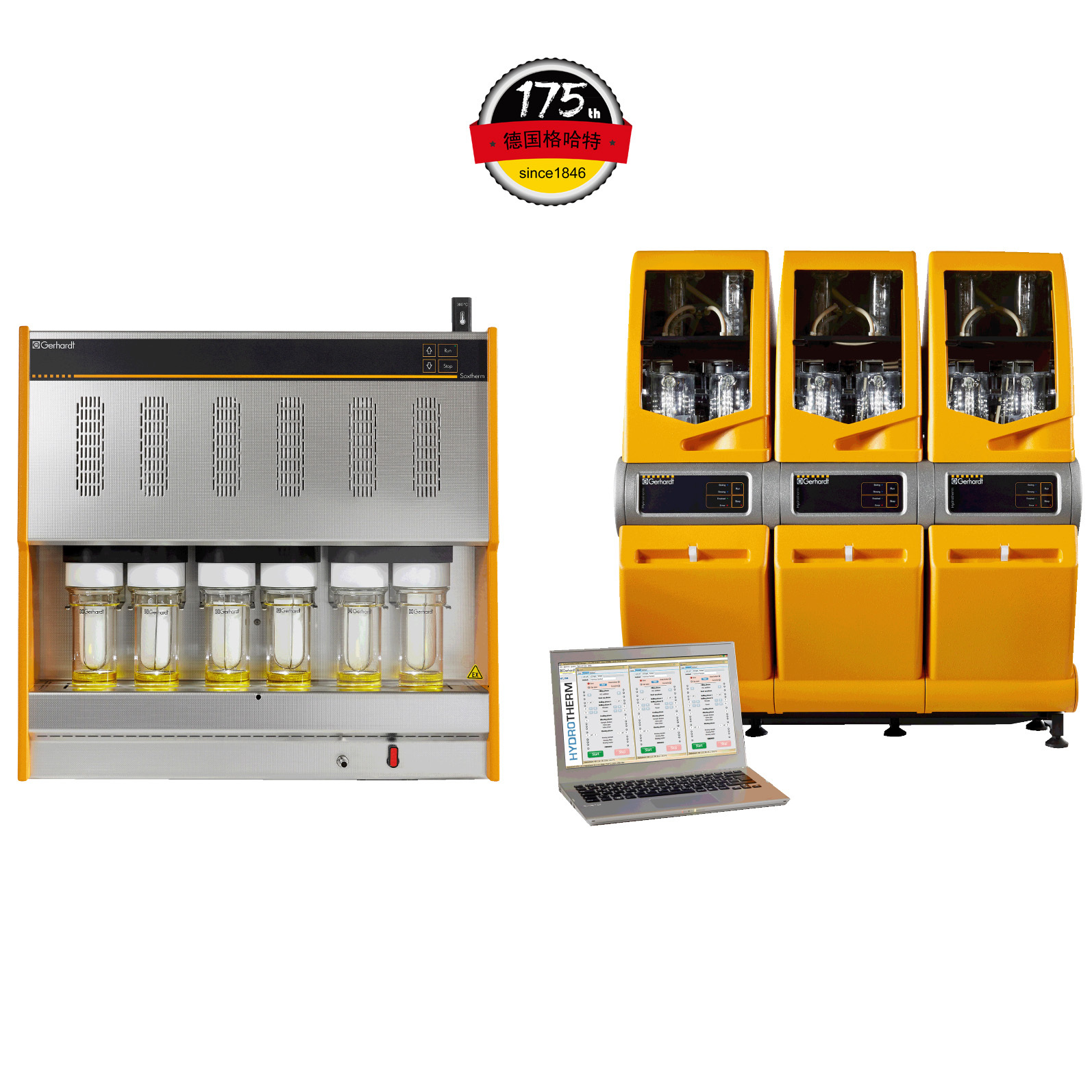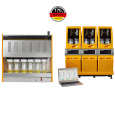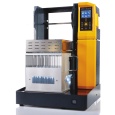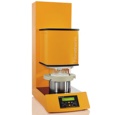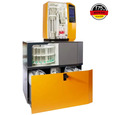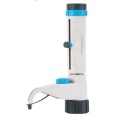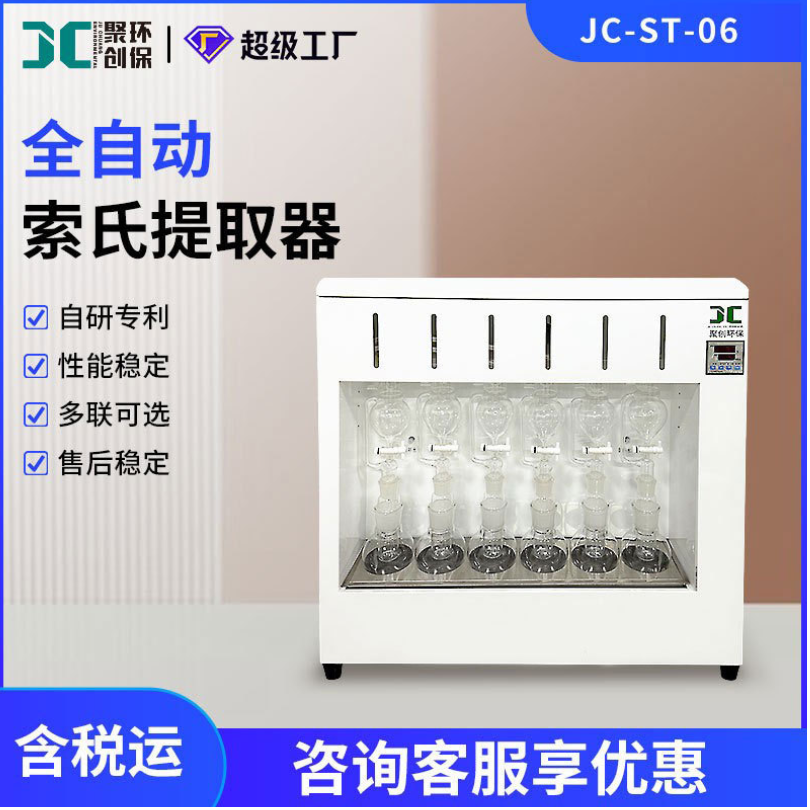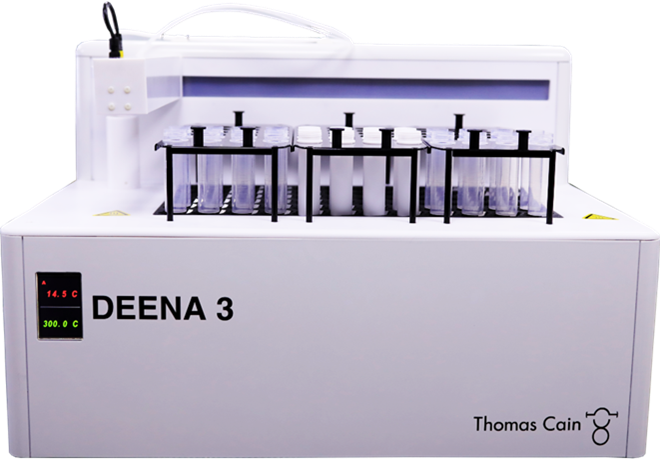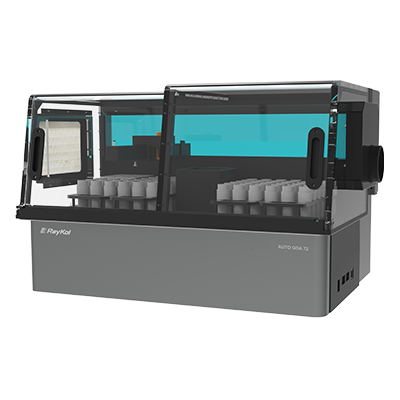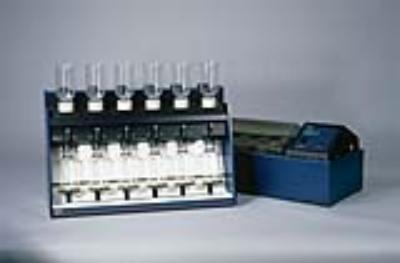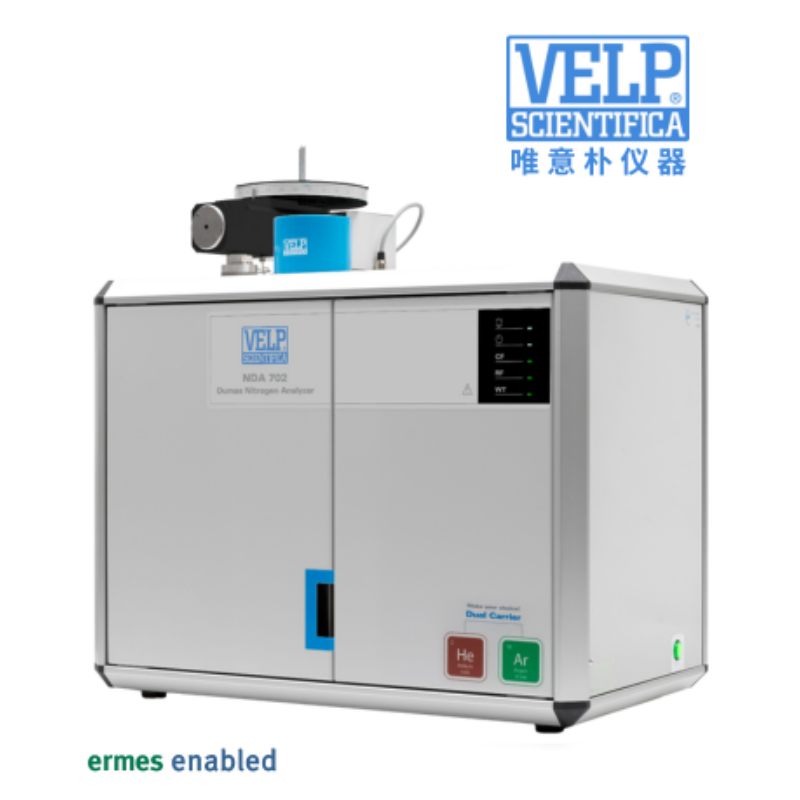用可持续的高纤维饮食处理完整的雄性葡萄牙阿伦特哈诺猪:对血液、生长、尸体、肉质和猪味化合物的影响Outdoor Finishing of Intact Male Portuguese Alentejano Pigs on a Sustainable High-Fiber Diet Impacts on Blood, Growth, Carcass, Meat Quality and Boar Taint Compounds
方案详情

用可持续的高纤维饮食处理完整的雄性葡萄牙阿伦特哈诺猪:对血液、生长、尸体、肉质和猪味化合物的影响Outdoor Finishing of Intact Male Portuguese Alentejano Pigs on a Sustainable High-Fiber Diet Impacts on Blood, Growth, Carcass, Meat Quality and Boar Taint Compounds2 of 19Animals 2023, 13,2221 Article 用可持续的高纤维饮食处理完整的雄性葡萄牙阿伦特哈诺猪:对血液、生长、尸体、肉质和猪味化合物的影响 Outdoor Finishing of Intact Male Portuguese Alentejano Pigs on a Sustainable High-Fiber Diet: Impacts on Blood, Growth, Carcass, Meat Quality and Boar Taint Compounds Jose Manuel Martins 1,2*D , Ricardo Varino2, Rui Charneca 1,2D , Andre Albuquerque 2,3D, Nicolás Garrido 23D , Jose Neves 1,2D, Amadeu Freitas 1,2D , Filipa Costa 2, Carla Marmelo 2,3D, Amelia Ramos 24D and Luisa Martin 24D 葡萄牙埃沃拉大学中海农业、环境与发展与变化研究所-全球变化与可持续发展研究所 1 MED-Mediterranean I nstitute for Agriculture, Env i ronment and Development & CHANGE-Global Change and Sustainability Institute, Departamento de Zootecnia,ECT-Escola de Ciencias e Tecnologia, Universidade de Evora, Polo da Mitra , Ap. 94, 7006-554 Evora, Portugal; rmcc@uevora.pt (R.C.); jneves@uevora.pt (J.N.); aagbf@uevora.pt (A.F.) 2 ECO-PIG Consortium, Z.I . Catraia, 3440-131 S. Comba Dao, Portugal; eco-pig@outlook.com or varin0_96@hotmai l .com (R.V.); andrealb@uevora.pt (A.A.); nicolas.osa@uevora.pt (N.G.); lipaaa.costa@gmai l.com (F.C.); carla.marmelo@racoessantiago.pt (C.M.); amel i aramos@esac.pt (A.R.); luisam@esac.pt (L.M.) 3 MED & CHANGE, Universidade de Evora, 7006-554 Evora, Portugal 4 Departamento de Ciencias Agrarias e Tecnologias, Escola Superior Agraria de Coimbra, Bencanta,3045-601 Coimbra, Portugal 染 Correspondence: j martins@uevora.pt Citation: Mart i ns, J .M.; Varino, R.; Charneca, R.; Albuquerque, A.; Garrido, N.;Neves,J.; Freitas,A.; Costa,F;Marmelo, C.; Ramos, A.; et al. Outdoor Finishing of I ntact Male Portuguese Alentejano Pigs on a Sustainable High-Fiber Diet:Impac t s on Blood, Growth, Carcass, Meat Quality and Boar Taint Compounds. Ani m als 2023, 13, 2221 ht t ps://doi .org/10.3390/ani13132221 Academic Editors: Giovanna Martelli and Eleonora Nannoni Received: 31 May 2023 Revised: 23 June 2023 Accepted: 3 July 2023 Published: 6 July 2023 Copyright: @ 2023 by the authors. L i censee MDPI, Basel, Switzerland. This article is an open access article distr i buted under the terms and conditions of the Creative Commons Attribution (CC BY ) l icense (https://creativecommons.org/licenses/by/4.0/) Simple Summary: EU consumers are increasingly concerned about the practice of surgical castration of male piglets. An alternative approach that i s more welfare-f riendly is to raise intact pigs, but it i s important to limi t boar taint in the meat and fat of these animals, which produces an off-odor and flavor rejected by consumers when perceived. One way to accomplish this is by diet manipulation, as reported in previous studies with commercia l non-castrated hybrid pigs selected for lean meat deposi t ion. In this trial, we tested the effect of sex on the blood, growth, carcass, and meat qual i ty as well as on the boar taint compounds of Alentejano pigs. The pigs were raised outdoors and fed commercial and fiber-rich diets, the latter known for their potential to reduce boar taint. The results show that outdoor raised intact Alentejano pigs grew faster and produced leaner and less saturated meat than castrated ones. Although the experimental diet had no significant effect on boar taint compounds, the levels detected on most Alentejano pigs were, however, below the threshold values for consumer detection. Abstract: This tria l evaluated t he effect of sex on the blood, growth, carcass, meat quality, and boar taint compounds in male Alentejano (AL) pigs (n=30). From ~40 to 130 kg LW, castrated (C) and intac t pigs (I and IExp groups) were fed commercial diets ad libitum. Between ~130 and 160 kg (slaughter), C and I pigs continued on commercial diets, while IExp were fed an experimental diet containing locally produced pulses and by-products aimed at reducing boar taint. At ~160 kg, blood urea levels were higher i n IExp than C pigs, triacylglycerols were lower in both i ntact groups, and cortisol was l ower in IExp. IExp pigs exhibited f aster growth, improved feed conversion ratio, carcass higher commercial yield and leaner meat than C pigs. The loin intramuscular fat in intact pigs was lower, less saturated and more polyunsaturated, while total collagen was higher. Fat androstenone content was higher in intact pigs and skatole content was similar across treatments, although they were below t hreshold values for consumer detection. Finally, although boar taint compounds were low in intact AL pigs raised outdoors, adding pulses and by-products to the experimental diet did not result i n a reduction in fat skatole content compared to pigs fed the commercial diet . Keywords: intact pigs; blood biochemistry; animal performance; Longissimus lumborum; androstenone; skatole 1. Introduction Consumer rejection of excess animal mea t and meat products fat and the inefficiency of (unwanted) fa t deposi t ion led to a reduction in the carcass fatness of commercia l pigs, namely through the rearing of non-castrated (intact) males for meat production [1]. How-ever, meat and fat from some intact male pigs present an off-odor and f lavor known as boar taint, which was mainly caused by the accumulation of androstenone (5o-androst-16-ene-3-one) [2] and skatole (3-methylindole) [3] in adipose t issue. Androstenone (AND),a steroid hormone produced and secreted by the testes, has a urine-like smel l, whereas ska-tole (SKA),produced by tryptophan bacterial degradation i n the hind gut, has a fecal-like odor [4,5]. The deposition of these compounds in the carcasses of intact pigs is a complex process that i s affected by several factors such as age, sexual activity, feeding, and genetic background [4-6]. Male surgical castration has been widely practiced, mainly to diminish aggressive behavior and boar taint, that can reduce meat's consumer acceptance. In the last f ew decades, EU animal welfare organizations, consumers and legislation increased pressure to study more welfare-friendly alternatives to the surgical castration of newborn piglets [7,8]. Avoiding castration i n pigs is beneficial for animal welfare, as well as from economic, social and environmental perspectives, as long as the l evels of AND and SKA in meat are minimized and agonistic behaviors are controlled [7,9]. Meanwhile, carcass and other quality traits of meat and fat, which influence the consumer acceptance of meat and meat products, may also be altered in intact pigs [8,10]. Nevertheless, published results in these traits, generally obtained i n commercial intact hybrid pigs selected for lean meat deposition, are not always consistent [11]. A still open question is to what extent the use of local and/or fatter pigs may result in higher incidences of boar taint [9,12]. The Alentejano (AL) pig i s a fatty local breed from the southern region of Portugal, and it is genetically similar to the Iberian pig [13]. T raditionally, i t is surgical l y castrated, raised outdoors, and slaughtered at heavy weights to develop the quality of i ts meat and meat products, which are generally considered superior to those of conventionally produced pigs [14]. However, due to current issues related to surgical castration [15], other solutions to reduce boar taint must be researched . One way to approach this issue i s through diet manipulation, as reported in commercial pig breeds [6,16]. Diet (f iber) modulation of AND deposition i n swine fat has given contradictory results, with some authors reporting decreases [6,17] and others not [18]. On the other hand,SKA content can be reduced by dietary feed composition. Fiber-rich diets can increase energy availability in the hind gut, shifting microbial activity from proteolytic to saccharolytic, and it can also reduce intestinal transit t ime, t hus reducing tryptophan microbia l breakdown and absorption [16,19]. Fermentable carbohydrates such as raw potato starch or chicory inulin were proven to decrease SKA concentrations in the backfat of commercial pig breeds [20,21]. The fermentation of carbohydrate-rich diets also favors the formation of short-chain fatty acids (SCFAs) such as butyrate in the colon [22]. This SCFA is related to the inhibition of apoptosis of the hind gut mucosa and the reduction in the production and deposition of SKA from endogenous tryptophan origin [18,19]. The aim of this trial was to compare, for the first time, the effec t of sex on the blood biochemistry, growth performance, carcass characteristics, and meat quality traits from heavy barrows and intact male AL pigs raised under outdoor conditions. Pigs were fed commercial growing-finishing diets used in Portugal and a sustainable high-fiber finishing experimental diet. The ingredients were chosen to minimize costs and environmental impact, using locally produced pulses and agro-industrial by-products with a reducing effect on boar taint compounds in commerc i a l intact pigs' fat reported in the l iterature. 2. Materials and Methods 2.1. Animals and Experimental Design Pure AL male pigs (n =30) raised outdoors from ~40 to 160 kg l ive weight (LW) were used to test the effects of sex on blood biochemistry, performance, carcass, meat quality and fat boar taint compounds. Animals, divided into three experimenta l groups (n=10 for each group) similar in genealogy, age, and body weight, were from two different sex types: Group C included pigs surgically castrated at an early age, under anesthesia and analgesia, and groups I and IExp included animals that were not surgically castrated (intact pigs). Each group was assigned to a 1000 m² park with a battery of individual stalls, which were equipped with feeders and drinking nipples . Each park had a zinc shelter (16 m²) and dispersed trees. At the beginning of the hot season (mid-June), a water pond (~6 m²) was made available per park for thermoregulation and welfare purposes. From ~40 to 130 kg LW, pigs were fed commercial growing and fattening diets at an estimated ad libitum intake, as previously described [23]. From~130 to 160 kg, C and I pigs remained i n the fattening diet, while IExp pigs were fed an isoproteic and isoenergetic experimental diet (CP=13.8and 13.8 g/100 g DM, total lipids = 6.2 and 6.8g/100 g DM, digestible energy = 13.1 and 13.2 MJ/kg DM for the experimental and commercial diets, respectively) (for detailed composi t ion, see Table S1). The experimental diet included locally produced pulses and agro-industrial by-products, and its formulation is proprietary information. Diets were fed in a single daily meal (09:00 h) until the beginning of the hot season, when they started to be fed twice a day (09:00 and 19:00 h). Pigs were fed at a weekly-adjusted daily rate, had free access to water, and individual diet refusals were measured daily. Blood samples were collected before the morning meal from overnight fasted animals at ~120 and 160 kg LW, using the orbital sinus bleeding technique [24]. Serum obtained by centrifugation (2500×g 4°C for 10 min; Fiberlite F21-8 ×50 y rotor, Sorvall Lynx 4000; Thermo Scientific, Waltham, MA, USA) was frozen (-80°C) (HFU686 Basic; Heto, Brondby, Denmark) unti l analysis. At the end of 27 weeks of trial, lasting from mid-April to October, pigs were killed with an average of 157.1 ± 1.3 kg LW, by Co stunning and bleeding at an industrial slaughterhouse. Animals from each experimental group were kept in a different pen and killed after a ~12 h fast during lairage, but they continued to have free access to water. 2.2. Serum Biochemistru T otal protein, urea, glucose, triacylglycerols and total cholesterol were determined by commercial Beckman Coulter enzymatic kits on a Beckman Coulter DxC 700 AU analyzer (Beckman Coulter, Brea, CA, USA). Cortisol concentrations were assessed with an Immulite 2000 cortisol assay on an IMMULITE 2000° autoanalyzer (DPC, Los Angeles, CA, USA). Finally, testosterone levels were determined using a commercial DIAsource TESTO-RIA-CT kit (DIAsource Immunoassays S.A., Louvain-la-Neuve, Belgium). 2.3. Carcass Traits and Tissue Sampling After evisceration, the hot carcasses were weighed, and measures were taken on the split left half-carcasses. Backfat thickness was averaged from two measures taken at the 10th rib and between the last thoracic and first lumbar vertebrae. Zwei punkte'(ZP) fat and muscle depths were determined, respectively, as the minimal fat depth (including rind) over the Gluteus medius muscle and the minimal muscle depth between the cranial end of the Gluteus medius and the dorsal part of the medullar canal . Carcasses were divided into commercial cuts as previously described [24], and their individual weights were recorded. Samples of Longissimus lumborum (LL) muscle were collected from the left-half carcasses, refrigerated (4 °℃) or vacuum-packaged and frozen (-20°C) until analyses. 2.4. Diets and Muscle Analyses The moisture content in LL samples was determined as previously described [24]..The musc l e total nitrogen was analyzed by the Dumas combustion method d (method 992.15)[25] ,a nd crude protein content was subsequently calculated (N×6.25). Tota l lipids were extracted from muscles according to Folch et al . [29]. Fatty acids (FAs) were transesterified into methyl esters [30], and their identification and profiling were performed using a Shimadzu GC-MS2010 Plus chromatograph (Kyoto, Japan) equipped with a SP-2560 capillary column (100 m x0.25 mm I.D., 0.20 um) (Supelco, Bellefonte, PA, USA). Muscle total ashes were determined by carbonization and i ncineration in a muffle furnace (550°C). U l timate pH (pHu) values were measured using a pH meter with a puncture electrode (LoT406-M6-DXK-S7/25,Mettler-Toledo GmbH, Gieen, Germany)as previously described [24]. EZ drip loss [31] was determined on ref r igerated LL samples, and t hawing and cooking losses were determined on LL chops (8×5×4 cm) as described in [23]. The haem pigment concentration was determined [32] and then multiplied by 0.026to obtain the myoglobin content [33].Total hydroxyproline e was analyzed according to Woessner [34] and multiplied by t he factor of 7.14 [35] to obtain the total collagen content of muscle samples. Soluble collagen was determined according to Hill [36]. Objective color was measured on raw muscles (after 30 min of blooming) using a CR-400 colorimeter (Konica Minolta Sensing Europe B.V., Nieuwegein, The Netherlands) equipped with a D-65 illuminant, as previously described [24]. CIE (Commission Interna-tionale de I'Eclairage) L* (lightness), a* (redness), and b* (yellowness) values were averaged out of six random readings across each LL sample sur f ace. The chroma, hue angle, and saturation were calculated using t he following equations: chroma (C)=√(a*2+b*2); hue angle (H°)= tan-1(b*/a*); saturation=C/L*. Warner-Bratzler shear force (WBSF) was measured perpendicular to the direction of LL fibers i n rectangular cooked meat sections (1×1×3 cm) using a Texture Analyser TA HD Plus (Stable Micro Systems Ltd., Surrey, UK) and a Warner-Bratzler V-shaped shear blade (1.2 mm thick) as described in [23]. Averaged values from at least 10 sections of each LL sample were used for statist i cal analysis. Lastly, AND and SKA contents were determined in neck subcutaneous fat samples of pigs by HPLC, following the method of Hansen-Meller [37] modified by [38]. 2.5. Calculations and Data Analyses Results are presented as means ± standard errors (SE). All data were tested for nor-mality by the Shapiro-Wilk test. Statistical analysis was performed by one-way analysis of variance (ANOVA) with the IBM SPSS Statistics software (IBM SPSS Statistics for Windows, v24.0, IBM Corp., Armonk, NY, USA). Statistical analysis was performed according to the following model, using the animal group as a fixed effect: where “yj i m" is the observat i on jm;“p" is t he mean of the model; Trt; is the treatment group where j = Intact, Intact Experimental and Castrated; and ejm is the error of the observation jm Dif f erences were considered significant when p <0.05 and p-values between 0.05 and 0.10 were considered trends. 3. Results During the experimental period, the average temperature, minima l and maximal temperatures, and relative humidity were, respectively, 20.8C, 13.0°C,30.1°C, and 53.4%. Al l pigs remained in good health throughout this period. 3.1. Growth Data Al l experimental groups had similar initial weights, total weight gain during trial and slaughter weights (Table 1). However, t he overall average daily gain (ADG) was different among groups (p <0.008), with C pigs presenting the lowes t ADG, while IExp had the highest (13.4% higher than C pigs). I pigs presented an i ntermediate ADG, which was 6.5%higher than that of C pigs but did not reach statistical significance. These differences were primarily observed during specific weight ranges, with higher ADG in intact pigs (I and IExp) between ~40 and 60 kg and ~120 and 130 kg, and higher ADG of IExp pigs compared to C and I pigs between ~130 and 160 kg LW (Table 1). The tota l duration of the trial was also affected by the experimental treatments, with the C pigs requiring a significantly longer t ime (p <0.001) to reach the slaughter weight compared to intact pigs (I and IExp groups). In f act, castrated pigs needed 9.8% more days to attain the slaughter weight than I pigs and 15.1% more days than IExp pigs (Table 1). The average total feed intake was lower (p <0.0001) i n I (-11.8%) and IExp(-17.2%) compared to C pigs. Additionally, the average total feed rejec t ion was higher (p <0.0001) in I than in IExp and C pigs. These differences between experimental groups were significant only during the fattening period (from ~120 to 160 kg LW). Finally, the feed conversion ratio (FCR) differed significantly (p <0.0001) among al l experimental groups , being lower in IExp and higher in C pigs, with intermediate values in I pigs (Table 1). Table 1. Growth performance from castrated (C), intact (I) and intact experimental (IExp) Alentejano pigs slaughtered at ~160 kg LW (n=10 per group)#. C I IExp p-Value Mean SE Mean SE Mean SE [nitial weight (kg) 41.1 0.8 42.6 0.8 41.8 1.1 0.510 Final weight (kg) 158.1 1.5 156.2 2.7 157.2 2.4 0.830 Total weight gain (kg) 117.7 1.8 114.7 3.4 115.7 2.4 0.708 Days on trial (d) 192.5a 4.7 175.3b 2.0 167.2b 4.0 <0.001 Average total feed intake (ATFI) (kg) 543.6a 3.8 479.6b 5.4 450.2° 3.0 <0.0001 ATFI ~40-60 kg LW(kg) 77.4 6.3 66.8 3.0 68.1 3.4 0.206 ATFI ~60-120 kg LW (kg) 202.4 4.5 200.0 7.4 189.1 5.3 0.250 ATFI ~120-130 kg LW (kg) 116.0a 7.6 53.9b 6.2 62.2b 10.8 <0.0001 ATFI ~130-160 kg LW (kg) 148.4 6.9 159.1 12.2 131.5 16.4 0.304 Average total feed rejekctoioWn (ATFR)(kg)ATFR~40-60 kg LW (kg) 4.5b 1.6 26.4a 4.8 3.9b 1.6 <0.0001 0.00 0.00 0.00 0.00 0.00 0.00 ATFR ~60-120 kg LW (kg) 0.31 0.27 4.88 2.74 0.65 0.26 0.097 ATFR~120-130 kg LW (kg) 0.35b 0.19 5.35a 1.90 0.46b 0.22 0.005 ATFR~130-160 kg LW (kg) 3.82b 1.38 16.20a 2.10 2.78b 1.63 <0.0001 Feed conversion ratio (FCR) (kg/kg) 4.63a 0.08 4.21b 0.13 3.90C 0.06 <0.0001 FCR ~40-60 kg LW 3.83 0.35 3.21 0.13 3.23 0.07 0.097 FCR~60-120 kg LW 3.94a 0.05 3.91a 0.11 3.61b 0.09 0.022 FCR ~120-130 kg LW 5.32a 0.27 3.70b 0.32 4.03b 0.61 0.029 FCR ~130-160 kg LW 6.74 0.21 6.42 0.72 5.33 0.32 0.119 Average daily gain(ADG)(g/d) 609.6b 12.2 649.2 ab 21.6 691.2a 15.4 0.008 ADG~40-60kg 482.6b 12.9 558.5a 14.9 556.0a 12.6 <0.001 ADG~60-120kg 689.5 11.8 717.8 21.9 741.6 16.6 0.124 ADG~120-130kg 686.5b 29.3 936.4a 80.8 935.7a 74.6 0.016 ADG~130-160kg 591.1b 21.6 595.0b 53.5 732.2a 46.8 0.048 # C and I pigs consumed commercial diets until slaughter, IExp pigs consumed commercial diets until ~130 kg and t he expe r imental diet from ~130 kg until slaughter; a,bc Values i n the same row with different superscript letters are signif i cantly di f ferent (p<0.05). 3.2. Fasting Serum Parameters The experimenta l t reatments did not have a significant effect on tota l protein, glucose, and total cholesterol l evels at both blood collection weights (~120 and 160 kg LW) (Table 2). Table 2. Blood biochemistry from castrated (C), intact (I) and intact experimental (IExp) Alentejano pigs (n = 10 per group) at different l ive weights #. C I IExp p-Value Mean SE Mean SE Mean SE Blood collected at ~120 kg LW Total protein (g/L) 64.6 1.1 62.2 1.5 64.0 1.5 0.454 Urea (mmol/L) 4.96a 0.13 4.05b 0.22 3.33° 0.16 <0.0001 Glucose (mmol/L) 4.07 0.11 4.35 0.15 4.26 0.15 0.366 Triacylglycerols (mmol/L) 0.28 0.01 0.29 0.02 0.33 0.02 0.163 Total cholesterol (mmol/L) 2.49 0.08 2.17 0.08 2.47 0.20 0.215 Cortisol (nmol/L)T 177.2 54.8 125.4 18.1 127.3 12.6 0.382 Testosterone (nmol/L)T 0.21C 0.03 10.70b 0.89 19.03a 2.88 <0.0001 Blood collected at ~160 kg LW Total protein (g/L) 65.3 1.6 64.3 1.8 66.2 2.7 0.809 Urea (mmol/L) 4.01a 0.21 3.36 ab 0.30 3.11b 0.17 0.034 Glucose (mmol/L) 4.12 0.11 4.20 0.12 4.15 0.10 0.876 Triacylglycerols (mmol/L) 0.53a 0.04 0.37b 0.04 0.30b 0.03 <0.001 Total cholesterol (mmol/L) 2.41 0.12 2.12 0.21 2.10 0.19 0.418 Cortisol (nmol/L)T 204.4a 22.4 232.0a 31.4 78.9b 7.8 <0.001 Testosterone (nmol/L)T 0.26° 0.03 16.34b 2.98 25.02a 2.34 <0.0001 # C and I pigs consumed commercial diets unti l slaughter, IExp pigs consumed commercial diets until ~130 kg and the experimental diet from ~130 kg until slaughter;t Blood of 7 pigs per group analyzed; abe Values i n the same row with di f ferent superscript letters are signif i cantly different (p <0.05). At ~120 kg LW, the fasting urea was different in all experimental groups, being 18.3 and 32.9% lower (p <0.0001) in I and IExp than in C pigs. This difference was still observed at ~160 kg, with IExp pigs having a 22.4% lower urea level (p= 0.034) than C pigs (Table 2). Triacylglycerol levels were not affected by experimental treatments at 120 kg, but at 160 kg, both intact groups showed lower levels (p <0.001) compared to C pigs (-30.2in I and -43.4% in IExp pigs). Cortisol levels were also different at 160 kg, being lower (p<0.001) in IExp t han in I and C pigs (2.9 and 2.6 times, respectively). Finally, testosterone levels at 120 and 160 kg were significantly different (p <0.0001) among all experimental groups, with castrated pigs presenting a residual value. When compared to castrated ones, blood testosterone levels were higher in I and IExp pigs at 120 (~50 and 90 t imes higher, respectively) and 160 kg (~62 and 96 times higher) (Table 2). 3.3. Carcass Characteristics and Cut Proportions Hot carcass weight tended (p=0.051) to be different between experimental groups, with C pigs having the highest carcass weight and I pigs having the lowest (Table 3). Carcass yield was significantly different among all groups (p<0.001), being 4.3%lower in I and 1.5% lower in IExp when compared to C pigs. However, commercial yield was higher (p<0.001) i n intac t (+4.7 in I and +4.9% in IExp) than i n castrated pigs, which was primarily due to higher proportions of untrimmed shoulder (p <0.0001) and tenderloin (p=0.028). These differences in intact animals resulted in a higher (p <0.001) proportion of primal cuts in intact pigs (+4.8 in I and +5% in IExp) than in castrated ones. Conversely, the percentage of f at cuts was lower (p <0.0001) in i ntact (-12.9 in I and -13.9% in IExp) than in C pigs, which was mainly due to a lower proportion of belly and backfat cuts i n the former. Backfat thickness and ZP fat depth confirmed these results , being lower (p<0.0001) in intact pigs (-29.9 and -26%,and -26 and-22.5% in I and IExp, respectively) than in castrated ones (Table 3). These differences in the distribution of lean and fat cuts led to a higher (p<0.0001) lean to fat cuts ratio in intact (+20.2 in I and +21.5% in IExp) than in C pigs, confirming that both intact groups produced leaner carcasses. Finally, the percentage of bone cuts was higher (p=0.011) in I (+16.9%) and IExp (+13%) than in C pigs, which was primari l y due to a significantly higher percentage of neck (bone-in) cut in intac t pigs. This resulted i n a 25% lower lean to bone cuts ratio i n intact than i n C pigs (Table 3). Table 3. Carcass, and cut t raits data from castrated (C), intact (I) and intac t experimental (IExp) Alentejano pigs slaughtered at ~160 kg LW (n =10 per group)# C I IExp p-Value Mean SE Mean SE Mean SE Hot carcass weight (kg) 124.7 1.3 117.7 2.2 121.9 2.1 0.051 Carcass yield (%) 78.8a 0.2 75.4° 0.5 77.6b 0.2 <0.001 Commercial yield(%) 46.6b 0.5 48.8a 0.3 48.9a 0.3 <0.001 Untrimmed shoulder (%) 17.1b 0.3 19.4a 0.3 20.1a 0.2 <0.0001 Loin (%) 4.59 0.13 4.91 0.08 4.53 0.14 0.068 Untrimmed ham (%) Tenderloin (%) Primal cuts (%)2 Bone cuts (%)3 Neck (bone-in;%) 24.5 0.4 24.0 0.1 23.7 0.3 0.168 0.49b 0.01 0.57a 0.02 0.52 ab 0.02 0.028 46.1b 0.5 48.3a 0.3 48.4a 0.3 <0.001 7.7b 0.2 9.0a 0.2 8.7a 0.2 0.011 4.05b 0.16 4.96a 0.20 4.98a 0.17 0.001 Ribs (%) 3.65 0.13 4.00 0.17 3.72 0.08 0.145 Fat cuts (%) 4 28.7a 0.3 25.0b 0.4 24.7b 0.4 <0.0001 Belly(%) 12.6a 0.4 10.0b 0.4 10.9b 0.4 <0.001 Backfat (%) 16.1a 0.4 15.0a 0.3 13.8b 0.5 0.002 Lean to fat cuts ratio 1.63b 0.03 1.96 0.04 1.98a 0.04 <0.0001 Lean to bone cuts ratio 6.1a 0.2 5.5b 0.1 5.7b 0.1 0.024 Backfat thickness (mm) 68.2a 1.1 47.8b 3.0 50.5b 2.4 <0.0001 10th rib backfat thickness 72.8a 1.7 50.2b 2.8 52.4b 2.4 <0.0001 Last rib backfat thickness 63.7a 1.1 45.3b 3.3 48.5b 2.6 <0.0001 Fatness: ZP fat depth (mm)° 62.7a 1.9 46.4b 2.2 48.6b 1.4 <0.0001 Last rib LL thickness (mm) 54.8 1.5 60.1 2.0 57.8 1.5 0.102 Leanness: ZP muscle depth (mm) 7 64.4 1.1 67.8 1.3 64.7 1.1 0.092 # C and I pigs consumed commercial diets until slaughter, IExp pigs consumed commercial diets unt i l ~130kg and the experimental diet from ~130 kg unti l slaughter.Percentage relative to carcass of the sum of untrimmed shoulder, untrimmed ham, loin, and tenderloin cuts; 2 Percentage relat i ve to carcass of the sum of untrimmed shoulder, untrimmed ham, and loin cuts; 3 Percentage relative to carcass of the sum of neck (bone-in) and ribs cuts; 4 Percentage relative to carcass of the sum of belly and backfat cuts; 5 Average of measurements taken at the 10th r ib l evel , and l ast t horac i c and f i rst l umbar vertebrae (last r i b level); 6Minimal fat depth (i ncluding rind) over the muscle Gluteus medius;Minimal muscle depth between the anterior extremity of the muscle G. medius and the dorsa l part of the medulla r canal ; ab,c Values in the same row with different superscript letters are significantly di f ferent (p<0.05). 3.4. Muscle Physical-Chemical Composition The physical-chemical composition of the LL muscle was affected by experimental treatments (Table 4). LL total intramuscular fat (IMF), which is inversely related to moisture content, was lower (p= 0.004) in both intac t groups (-34 in I and -28.2% in IExp) than in C. However, total protein and ash content, as well as drip loss, thawing loss and cooking loss, were not affected by treatments. The color parameters of LL were also not affected by experimental treatments. Additionally, when compared to C pigs, the total collagen content in LL was higher (p=0.002) in both i ntact groups (+15 in I and +14% in IExp). However, although following the same trend, the soluble collagen content did not reach statistical significance (Table 4). Table 4. Chemical composition, pH, drip loss, thawing loss, cooking loss, CIE color and Warner-Bratzler shear force values of Longissimus lumborum from castrated (C), intact (I ) and intact experi-mental (IExp) Alentejano pigs slaughtered at ~160 kg LW (n =10 per group)#. C I IExp p-Value Mean SE Mean SE Mean SE Moisture (g/100 g) 71.4b 0.2 73.5a 0.3 73.0a 0.2 <0.0001 Total protein (g/100g) 22.3 0.4 21.8 0.2 21.5 0.6 0.503 Total intramuscular fat (g/100 g) 4.12a 0.36 2.72b 0.11 2.96b 0.31 0.004 Total ashes (g/100 g) 1.17 0.03 1.11 0.01 1.14 0.03 0.174 pH (24 h post mortem) 5.68 0.04 5.60 0.02 5.61 0.03 0.064 Drip loss (g/100 g) 0.27 0.03 0.53 0.15 0.46 0.11 0.212 Thawing loss (g/100 g) 1.57 0.24 0.94 0.18 1.09 0.18 0.100 Cooking loss (g/100g) 14.8 0.5 15.0 0.3 14.2 0.8 0.535 Myoglobin content(mg/g) 1.41 0.09 1.24 0.06 1.25 0.08 0.229 Lightness (CIE L*) 44.3 0.8 45.7 1.0 46.9 0.7 0.125 Redness (CIE a*) 13.5 0.6 13.0 0.7 12.2 0.4 0.254 Yellowness (CIE b*) 9.1 0.6 9.3 0.7 9.1 0.3 0.926 Chroma (C) 16.3 0.8 16.0 0.9 15.2 0.4 0.566 Hue angle (H°) 33.6 1.1 35.3 1.1 36.7 0.8 0.111 Saturation 0.37 0.02 0.35 0.02 0.33 0.01 0.169 Total collagen (mg/gDM) 17.9b 0.5 20.6a 0.6 20.4a 0.5 0.002 Soluble collagen (mg/g DM) 5.9 0.3 6.8 0.3 6.6 0.4 0.110 Warner-Bratzler shear force (N) 48.7 2.7 52.7 2.5 47.2 1.3 0.182 # C and I pigs consumed commercial diets unt i l slaughter, IExp pigs consumed commercial diets until ~130 kg and the experimental diet from ~130 kg until slaughter; ab Values i n the same row with different superscript letters are significantly different (p<0.05). 3.5. Fatty Acids Profile of Muscle Tissues Among the 26 FAMEs detected in the intramuscular lipids of AL pigs, the most abundant was oleic acid (C18:1 n-9). The proportion of oleic acid values varied between 46.6 and 47.7 g/100 g (IExp and C pigs, respectively) of total FAMEs analyzed (Table 5). Table 5. Main fatty acids profile of intramuscular lipids of Longissimus l umborum f rom castrated (C), intact (I ) and intact experimental (IExp) Alentejano pigs slaughtered at ~160 kg LW (n =10 per group)*. C I IExp p-Value SE Mean SE Mean SE Mean g/100 g of Total Fatty Acids Identified C14 1.25a 0.02 1.05C 0.02 1.18b 0.03 <0.0001 C16 25.3a 0.2 23.6b 0.2 24.1b 0.2 <0.0001 C18 10.2 0.2 9.9 0.3 10.1 0.2 0.620 C20 0.12 0.01 0.12 0.01 0.11 0.01 0.280 ZSFA 37.2a 0.4 35.0b 0.4 35.9b 0.4 0.001 C16:1n-7 3.47a 0.09 3.04b 0.13 3.10b 0.12 0.023 C16:1n-9 0.25b 0.01 0.38a 0.02 0.35a 0.02 <0.0001 C18:1n-7 3.97a 0.08 3.67b 0.13 3.57b 0.08 0.018 C18:1n-9 47.7 0.3 47.0 0.3 46.6 0.5 0.196 2MUFA 55.5a 0.3 54.3 ab 0.5 53.8b 0.6 0.034 C18:2 n-6 5.1b 0.1 8.0a 0.3 7.8a 0.3 <0.0001 C18:3 n-3 0.87b 0.02 0.98a 0.01 0.98a 0.02 <0.001 C20:2n-6 0.15b 0.01 0.22a 0.01 0.22a 0.01 <0.0001 C20:4 n-6 0.73 0.05 1.00 0.10 0.82 0.11 0.110 C20:5 n-3 0.029 0.003 0.044 0.006 0.035 0.005 0.099 C22:5 n-3 0.070 0.008 0.079 0.006 0.077 0.10 0.703 Table 5. Cont. C I IExp p-Value Mean SEMean SE Mean SE g/100 g of Total Fatty Acids Identified C22:6 n-3 0.008 0.002 0.006 0.003 0.003 0.002 0.407 ZPUFA 7.3b 0.2 10.8 0.4 10.3a 0.4 <0.0001 ZUFA 62.8b 0.4 65.0a 0.4 64.1a 0.4 0.001 ZUFA/SFA 1.69b 0.03 1.87a 0.04 1.79a 0.03 0.002 ZPUFA/SFA 0.20b 0.01 0.31a 0.01 0.29a 0.01 <0.0001 Zn-3 1.03b 0.03 1.18a 0.02 1.16a 0.02 <0.0001 Zn-6 6.2b 0.2 9.5a 0.4 9.1a 0.4 <0.0001 Zn-3/n-6 0.17a 0.01 0.13b 0.01 0.13b 0.01 <0.0001 Zn-6/n-3 6.0b 0.2 8.1a 0.3 7.9a 0.3 <0.0001 2n-9 48.0 0.3 47.4 0.4 47.0 0.5 0.262 SAT index T 0.59a 0.01 0.53b 0.01 0.55b 0.01 0.001 ATH index+ 0.49a 0.01 0.43C 0.01 0.45b 0.01 <0.0001 #C and I pigs consumed commercial diets until slaughter, IExp pigs consumed commercial diets until ~130kg and t he experimental diet from ~130 kg unti l s l aughter;* Saturat i on index = (C14:0 + C16:0+ C18:0)/(ZMUFA+ZPUFA);+ Atherogenic index =[C12:0+(4×C14:0)+C16:0]/(ZMUFA +Zn-6+Zn-3); a ,b ,c Values i n t he same row with different superscript letters are significantly different (p <0.05). The composition of the main FAs in the intramuscular l ipids of LL was affected by the experimental treatments. The proportion of saturated fatty acids (SFA) was lower (p=0.001)in both groups of intact pigs (-5.9 in I and -3.5% in IExp) t han in C pigs. This was primarily due to the lower proportion (p <0.0001) of myristic (C14:0) and palmitic acid (C16:0), which is the second most abundant FA. Regarding monounsaturated fatty acids (MUFA), their proportion was lower (p=0.034) in IExp than in C pigs, which was mainly due to the lower proportions of palmitoleic (C16:1 n-7,p=0.023) and cis-vaccenic (C18:1 n-7,p=0.018) acids. However, t he proportion of oleic acid was not significantly affected by the experimental t reatments. On the other hand, the proportions of polyunsaturated fatty acids (PUFA) were higher (p<0.0001) in both groups of intac t pigs (+47.9 in I and +41.1% i n IExp) than in C pigs, which was primarily due to the higher proportion (p <0.0001) of li noleic acid (C18:2 n-6) (Table 5). Consequently, the PUFA to SFA ratio was also higher (p< 0.0001) in both i ntact groups (+55 in I and +45% in I Exp) than in C pigs. The proportions of n-3 and n-6 FA, as well as the n-6 to n-3 ratio, were higher (p<0.0001) in both groups of intact pigs (+35 in I and +31.7% in IExp) compared to C pigs. Finally, the saturation and atherogenic indexes were lower (p=0.001 and p <0.0001, respectively) in both groups of intact pigs (-10.2 and -6.87%,and -12.2 and -8.2% in I and IExp, respectively) than in C pigs (Table 5). 3.6. Androstenone and Skatole Content in Neck Subcutaneous Fat Tissue The content of AND in the neck subcutaneous fat was significantly different between groups, being higher (p <0.0001) in both intac t groups (~23.6 in I and ~25.5 times in IExp) than in C pigs (Table 6). On the other hand, the content of SKA was not affected by experimental treatments. It was simi l ar in I, IExp, and in castrated pigs (Table 6). Table 6. Androstenone and skatole content of the neck subcutaneous fat from castrated (C), intact (I ) and intact experimental (IExp) Alentejano pigs slaughtered at ~160 kg LW (n=10 per group)*. C I IExp p-Value Mean SE Mean SE Mean SE Androstenone (ng/g) 28.4b 17.1 669.5a 89.9 725.0a 98.4 <0.0001 Skatole (ng/g) 1.08 0.00 2.34 1.26 7.56 6.48 0.454 # C and I pigs consumed commercial diets unti l slaughter, IExp pigs consumed commercial diets until ~130 kg and the experimental diet from ~130 kg until slaughter; ab Values in the same row with dif f erent superscript letters are s i gnificantly di ff erent (p<0.05). 4. Discussion 4.1. Growth Data Although productive data from intact AL male pigs are limited, the overall ADG obtained in intact pigs during this t rial was identical to that of AL boars fed ad libitum until ~120 kg [39]. Similarly, the ADG of castrated AL pigs was identical to that of barrows fed ad libitum between 65 and 150 kg [23]. However, there were significant differences in ADG among groups, with IExp presenting a higher ADG than C pigs, while I pigs had intermediate values. These differences in ADG led intact animals (I and IExp pigs) to attain the slaughter weight faster than castrated ones, which was mainly due to a shorter fattening period (from ~120 to 160 kg: 56.3,59.4 and 69.2 days for I, IExp and C pigs, respectively). Additionally, the average total feed i ntake was lower in both groups of intact pigs than in C pigs. Boars'lower feed consumption is generally correlated to higher concentrations of testosterone either through a direct effect of the anabolic hormone or through satiety mechanisms [40]. Furthermore, intact pigs had a shorter trial duration, which could partly explain their lower feed intake. Moreover, visual observations showed a higher occurrence of aggressive and/or mounting behaviors in I (and C) than in IExp pigs during the periods preceding feeding time. These behaviors might have contributed to the reduced feed consumption observed in the I group. Additionally, I pigs showed higher feed rejections, which was possibly due to their negative response to the less well-granulated nature of the fattening diet when compared to the growing and experimental diets, which was probably due to a higher content in fat (see Table S1). The FCR values observed for intact and castrated pigs were slightly lower than the ones reported by Freitas et al. [39] and Martins et al. [23], respectively. Although increasing in all the groups from ~40 to 160 kg, these ratios were different among groups, with the lowest value in IExp and the highest in C. The fact that castrated pigs presented higher FCR as well as higher carcass fat deposition (see below), as previously observed [41], agrees with the higher energy value of LW gain in fat when compared to lean tissues. 4.2. Blood Parameters Studies involving biochemical blood parameters from castrated f inishing AL pigs are scarce [23] and, to our knowledge, there are no published data available for intact males. In this trial, the plasma metabolites determined in AL pigs at ~120 and 160 kg LW (~34and 42 weeks of age, respectively) generally fell within the normal physiological reference values observed in growing-finishing pigs of lean European breeds [42]. Total cholesterol levels were slightly lower than the reference values (3.05-3.10 mmol/L) probably due to the fact that our experimental pigs had ample space for physical activity, leading to the known effects of exercise on cholesterol metabolism [24]. Serum parameters of C pigs were generally consistent with those reported for ~120 and 160 kg castrated AL pigs fed at 85% ad libitum [24]. However, when comparing the experimental groups, urea l evels were significantly l ower in intact (I and IExp) than in C pigs, i ndicating a more efficient nitrogen use for lean tissue growth [43]. In obese breeds such as AL, high blood levels of urea [44] or triacylglycerols and cholesterol [41,45] are assoc i ated with increased fat deposition, as observed in the fatter C pigs in this trial (see below). Amino acids not used for body protein synthesis are deaminized and raise blood urea nitrogen, while their carbohydrate backbone is used for energy, contributing to adipose tissue accretion [45]. The higher triacylglycerol levels in C pigs at ~160 kg may also be associated to increased food intake and to the consumption of diets rich in lipids or fast-absorbing carbohydrates [41], as observed during the fattening period. Therefore, differences in glucose and lipid metabolisms as well as protein metabolism seem to affect subcutaneous adipose tissue accretion i n fat-type pigs [45]. Regarding cortisol levels, they increased between ~120 and 160 kg LW in I and C groups (+85 and+15%, respectively), while in the IExp group, they decreased (-38%). At ~160 kg, these levels were significantly lower in IExp than in I and C pigs, suggesting lower stress levels on the former group. This aligns with the observed number of skin injuries related to agonistic i nteractions in pigs in the last week of trial, 4 in IExp, 8 i n I and 9 in C pigs. Conversely, higher stress levels (cortisol concentration), and physical interactions observed (indirectly accessed by the number of skin injuries) in I when compared to IExp pigs may account for their lower FCR, as previously observed in Iberian pigs [46]. In fact, stress and physical activity in standing pigs has a high energetic cost [14]. As expected, testosterone l evels were negligible i n castrated pigs. Moreover, at ~120 and 160 kg, they were higher in IExp than in I pigs, but they were not related to a higher level of cortisol or skin injuries. Contrary to what was mentioned by Giersing et al. [47], this suggests that there may not be a direc t relation between testosterone and aggression levels, as previously observed in commercial hybrid pigs [48]. The relationship between male gonadal hormones and aggressive behavior is complex and influenced by various factors such as species, age, puberty stage, environment, and locally produced estrogens in the male brain [49]. Additionally, i t should be noted that the single serum measurement of testosterone obtained in this trial does not account for the circadian variation of this hormone. Finally, testicular steroids play a role in growth and development, with testosterone known to stimulate protein synthesis and decrease muscle protein degradation [4], thereby i mproving carcass lean meat proportion, as observed in both intact groups (I and IExp) (see below). 4.3. Carcass Characteristics and Cut Proportions 4.4. Muscle Physical-Chemical Composition The moisture and protein content of C pigs' LL muscle were similar to those observed in ad libitum fed castrated AL pigs slaughtered at ~150 kg BW [23]. However, their IMF content was l ower i n this tr i al , which was probably due to differences in the f inishing diet used (with ~8.5% higher digestible energy than the one used in the previous trial). The muscle chemical and physical composition was affected by sex. In l ine with the reduced body fat deposition, non-castration resulted in a lower IMF and increased moisture content when compared to values observed in C pigs. This was previously observed in Iberian pigs slaughtered at ~118 kg LW [53]. Still, the IMF values observed in both intact groups were above 2.5 g/100 g, a threshold below which some meat quality characteristics such as taste, flavor, and juiciness may be negatively affected [54]. The observed pHu values fell within the normal range for meat, which varies between 5.5 and 5.8 [55], and they were not affected by the experimental treatments. The pH is related to several meat quality characteristics, including the L* value and drip loss, which were also not affected by experimental t reatments. Meat color, considered the major visual factor affecting meat quality [56], remained unaffected by the experimental treatments, suggesting that consumers' visual perception of meat from i ntact and castrated AL pigs would be comparable. Management practices t hat modify muscle accretion rates and growth can affect collagen characteristics [57]. As observed in this trial, LL muscles from intact males often have a slightly increased collagen concentration compared to those from C pigs. Additionally, the soluble collagen concentration is usually the same or greater in intact males [58]. These anabolic effects of testosterone in collagen synthesis can sometimes be associated with increased shear force scores of cooked meat [57]. However, this was not observed on our trial, as previously reported in commercial breeds [10]. 4.5. Fatty Acids Profile of Muscle Tissues Lipid synthesis i n pigs primarily occurs in adipose tissue [59] and is positively corre-lated with the de novo synthesis of SFA and MUFA [59-61]. Endogenous oleic , palmitic, and stearic (C18:0) acids account for about 70% of the total FAs deposited [59]. In this trial, the composition of muscle FAs was affected by sex. Both intact groups (I and IExp) presented lower proportions of SFA and MUFA as wel l as higher proportions of PUFA. The decreases in SFA and MUFA proportions observed in leaner pigs are due to reduced de novo synthesis and the turnover of FAs [53,61]. This reduction is associated to the post-puberty increase in anabolic steroids [4], which typically begins at ~50 kg LW i n AL/Iberian pigs [62]. Conversely, the increase in fat deposi t ion due to de novo SFA and MUFA biosynthesis, as observed in C pigs, leads to a decline of the PUFA:SFA ratio [61]. The lower propor t ion of SFA observed in LL from i ntact pigs was mainly due to a palmitic reduction, as previously reported in commercial intact male pigs [15,60,61]and supported by a meta-analysis [7]. This reduc t ion is of interest due to the adverse effects of SFAs on consumer health [63], and it also affected the saturation index. Regarding the proportion of MUFA, it was lower in IExp pigs and higher in castrated ones, with I pigs presenting intermediate values. However, in contrast to findings in commercial intact male pigs [8,61], the difference in LL oleic acid between intact and C pigs was not statistically significant. Oleic acid can be synthesized through de novo elongation and the desaturation of its saturated homologue, and this desaturation process may be influenced by dietary n-6PUFAs, which impair stearoyl-CoA desaturase (SCD) gene expression [64] and activity [65]. Although the activity of this enzyme was not determined in this trial, we calculated the ratios of palmitoleic to palmitic acid and of oleic to stearic acid , which relate well with SCD activity [66]. These ratios were i dentical in the LL IMF of all experimental groups (0.14,0.13 and 0.13, and 4.7, 4.8 and 4.7 for C, I and IExp pigs, respectively), suggesting no significant regulatory effect of dietary PUFA intake on SCD activity. However, the levels of SCD mRNA determined in this t rial were lower in I pigs, increasing ~2.4 t imes from I to C pigs, with IExp ones presenting intermediate values (+1.7 times from IExp to C pigs). This suggests t hat the total intake of PUFAs (12% higher in I than in IExp pigs) may have affected the SCD expression level. Additionally, eicosapentaenoic acid (EPA) values (C20:5 n-3), ~52 and 21% higher in the LL IMF of I and IExp than C pigs, respec t ively, may also have exerted a suppressive effect on SCD mRNA, as previously suggested [67]. This discrepancy between SCD expression and oleic acid proportion in LL tissues may be explained by regulatory mechanisms such as SCD mRNA splicing, transcript transportation and/or translation [68] or the elongation and desaturation processes involving C18 mono-unsaturated and saturated FAs [59]. On the other hand, several authors have proposed SCD as a potential biomarker for fat deposition, as there is a significant positive correlation between SCD protein expression and the amount of IMF i n the muscle [69,70]. This is supported by our data, where increasing levels of SCD mRNA in LL corresponded to increasing l evel s of IMF (see Table 4). Furthermore, in line with previous reports [7,15], the LL IMF of intact pigs had higher levels of PUFAs than that of C pigs, albeit the fattening diet had ~7% more PUFAs than the experimental diet, and the dietary PUFA intake was lower in both intact groups, which was due to a lower average total feed intake compared to C pigs. A higher de novo lipogenic activity in C pigs could have reduced the proportion of PUFAs, which are derived entirely from the diet [59]. This difference in the IMF PUFAs of intact pigs was mainly due to a more than 50% higher content of linoleic acid and a ~12.5% higher content of l inolenic acid, which is of interest from the consumer’s health point of view [59]. The different proportions of these PUFAs also led to a higher total content of n-3 and n-6FAs in both intac t groups than in the C one. Since n-3 PUFAs enhance thermogenesis by re-partitioning FA away from triacylglycerol synthesis and toward oxidation, as reviewed by [71], they may have contributed to the lower body fat deposition observed in both intact groups. Meanwhi l e, the increase in l inoleic acid led to a signi f icant i ncrease in the 1-6 to n-3 ratio of intact pigs. A high n-6 to n-3 ratio is considered a prime risk factor for coronary heart diseases [59], but the values obtained in the IMF of the studied AL pigs'muscle presented a healthier profile when compared to t hat of commercial pigs, which was ~34 times higher [72]. In this trial, LL presented lower IMF content and a different FA composition in i ntact males when compared to castrated ones, which has both advantages and disadvantages. A diet low in animal fat with low levels of SFA and cholesterol can reduce the incidence of coronary heart disease [63]. The PUFA to SFA ratio is also considered an index of the status of foods as a risk factor for cardiovascular disease. It is hypothesized that diet PUFAs can reduce low-density lipoprotein cholesterol and serum cholesterol levels, while SFAs contribute to high levels of serum cholesterol [73]. Therefore, mea t from intact pigs presented a healthier PUFA to SFA profile than that of C ones. Additionally, the intact groups showed a significant reduction in saturation and atherogenic indexes, which is beneficial from a consumer’s health perspective [73]. On the other hand, t he changes in fat content and FAs observed in intact vs. castrated pigs may impact the subsequent processing and shelf-life of the produc t . In fact, the higher t he SFA level, like in C pigs, the better the processing and the lower the oxidation [8,60], whereas the higher the PUFA, such as in both i ntact groups, the greater the susceptibility to oxidation [50,74]. In a breed known for the quality of i ts meat and meat products, this is of paramount importance, and further studies are underway to evaluate this issue. 4.6. Androstenone and Skatole in Fat Tissues compounds reduce consumer acceptance of pork. To our knowledge, this is the f irst trial to make the determination of AND and SKA content in the subcutaneous fat of fattening AL pigs. Although challenging to establ i sh, backfat levels of 1000 ng/g for AND and 200 ng/g for SKA are commonly recognized as t hreshold values for distinguishing between tainting and non-tainting carcasses, as reviewed by [52]. In this trial , AND levels were significantly higher in both intact groups than in C, confirming that surgical castration effectively reduces AND concentration in pig fat tissue. Still, the average AND l evels in subcutaneous fa t from intact pigs remained below the threshold for consumer detection. Among the 20 intac t pigs analyzed, a high individual variation was observed (approximately f ive times in I pigs and four times in IExp pigs). Additionally, only four pigs, al l from the same two l itters, presented (borderline) higher than 1000 ng/g AND concentrations. Genetic background may partly explain the individual variation in AND content [76,77]. According to Weiler et al. [12], although low boar taint sire lines are now available, much of the propensity for commercial slaughtered pigs to exhibit boar taint comes f rom the dam l ines, which still need to be selected against boar t aint. On the other hand, even though no other AND and SKA data from AL pigs are available, when compared to the values observed in commercial breeds,e.g., [76,78], the AND level in the fat from intact male AL pigs in our trial could be considered low, especially considering their age at slaughter. This may be related to a genotype effect on AND levels, and it is particularly interesting since the intact pigs in our trial were slaughtered at the end of October with decreasing daylight hours, which is known to enhance AND concentrations when compared to those obtained in increasing daylength months such as April (9100 to 3800 ng/g,respectively)[79]. Similar results were obtained in decreasing artificial day length stimulation [4], confirming that season affects sexual maturation in pigs [80]. Regarding SKA levels, they were not statistically different between the experimental groups and were also low, with ~93% of the samples below 1.53 ng/g. Similar to AND, fat SKA l evels tend to i ncrease with age due to the inhibition of SKA degradation by AND and other testicular steroids [6,9]. Steroid hormones may also affect the l iver clearance of SKA [77], and reports of moderate genetic correlations between AND and SKA suggest that some genes may affect both traits [9]. In our t rial , increasing levels of testosterone from the C to IExp group (see Table 2) were associated to i ncreasing levels of AND and SKA (see Table 6). The low levels of SKA detected are also interesting considering the month pigs were slaughtered, since, as observed to AND, decreasing day length i s related to higher concentrations of SKA in fat and therefore higher boar taint sensation [80]. Avoiding competition at feeding and keeping pigs clean to prevent SKA absorption through the skin has also been associated with decreased SKA levels and lower boar taint [14]. In our trial, outdoor-raised pigs had 100 m² of space per pig and access to a pond in each park, allowing for clean and feces-free sleeping areas, which could partly explain the Dret low SKA deposition i n backfat by preventing the presence of fouled boars. Management at the farm level seems to play a role in limiting SKA levels, especially via innovative feeding strategies [9,77]. SKA i s produced in the colon of pigs through the microbial degradation of L-tryptophan [4]. Part of i t is converted to indole-3-acetic acid and then further degraded to SKA by highly specific bacteria, such as Lactobacillus sp. strain 11201, as reviewed by [19]. Therefore, any genetic or environmenta l factor that alters the microbial intestine composition can affect the deposition of SKA in fat [81]. Furthermore, SKA is primarily obtained by the digestion of feed proteins containing L-tryptophan [4,50], but i t can also be derived from tryptophan made available from microbial degradation of the (high turnover rate) intestinal mucosa cell debris [4]. Both processes of SKA formation can be reduced by dietary feed composition i n pigs. Fiber-rich diets stimulate microbia l growth and hind gut fermentation, which shortens the intestinal transit time and reduces the microbial breakdown of tryptophan, lowering SKA i ntestinal absorption [16,20]. Feeding beet, pulses such as lupins, and fermentable carbohydrates such as raw potato starch or chicory i nulin has been shown to decrease SKA levels in the backfat of commercial pig breeds [20,21,82]. By providing adequate amounts of carbohydrates, a shift f rom protein to carbohydrate intestinal fermentation leads to a lower t ryptophan content obtained from protein digestion and therefore lower SKA formation [82]. Finally, the fermentation of carbohydrate-rich diets promotes the production of short-chain fatty acids (SCFAs) in the colon, particularly from non-starch polysaccharides such as cellulose, B-glucans and arabinoxylans [22]. Butyrate i nhibits apoptosis of the hind gut mucosa, leading to less tryptophan available for SKA production and deposition [18,19]. This increased synthesis of SCFAs also contributes to lowering the colonic pH and may create an unsustainable environment for SKA-producing bacteria [19]. The f inishing experimental diet used at this trial included beet , l upin, peas, and malt rootlets. Although rich in fermentable carbohydrates, i t did not reduce SKA deposition in fat t issues from IExp pigs compared to those from (castrated and intac t ) animals consuming the commercial diet . The commerc i al f inishing diet used was formulated for AL pigs, which are known to digest f iber more efficiently than commercial breeds due to a higher cellulolytic and hemicellulolytic flora [83], and i t contained important amounts of total, soluble and insoluble fiber (see Table S1). This feature may have masked the intended variation in SKA fa t content between commercial and experimental-fed intac t pigs. The higher level of stress observed in I pigs may also have contributed as a modulator for the formation and accumulation of skatole [4]. However, intact AL male pigs presented mean levels of AND and SKA (more noticeable on the l atter) below threshold values used to differentiate between tainted and non-tainted carcasses [52]. In sensory evaluations, consumers in several European countries (including Portugal and Spain) found high levels of AND to be less noticeable when levels of SKA were low [10]. However, the importance of AND in consumer rejection should not be underestimated, and some recent publications suggest lower thresholds for consumer detection of AND (e.g., 500 to 1000 ng/g[84]). While consumer sensitivity to boar tain t compounds, particularly AND, varies, as reviewed by [85], their evaluation by trained panels, which i s currently underway for pork from pigs used in this trial, is important and will complement the chemical analyses of boar taint compounds. 5. Conclusions To the best of our knowledge, this is the first study to compare the effect of sex on blood, growth, carcass and meat quality traits as well as the fat boar taint compounds of fatty AL pigs slaughtered at this age and weight. In this trial, intact AL pigs raised outdoors and fed a high-fiber sustainable finishing diet with locally produced pulses and agro-industrial by-products were compared to intact and castrated AL pigs consuming a commercial diet. Overall, data showed that intact pigs grew faster and produced leaner and more unsaturated carcasses and meat than castrated ones. Although the experimental diet did not have any significative negative effects on the growth, carcass and meat quality traits of intact pigs, it did not lead to a significant reduction in fat SKA content. However, boar taint compounds i n the fat of both i ntact groups were lower than the threshold values proposed for consumer rejection, suggesting a genetic and a rearing system effec t . These results suggest t hat raising pigs of this local breed can be accomplished without resorting to castration, thereby i mproving animal we l fare and addressing consumer concerns related to this surgical prac t ice. As this is the first t ime that boar taint compounds levels in the fat of AL pigs are analyzed and published, further studies involving larger populations are required to validate these findings and access the i mpact of using meat and fat f rom intact AL pigs in meat products such as dry cured hams. Additionally, future studies should inc l ude a fourth experimental group consisting of castrated animals consuming the experimental diet. This would allow for the investigation of potential interactions between sex and diet, which was not included in this exploratory study due to logistical constraints. Supplementary Materials: The f ollowing supporting information can be downloaded at: ht t ps://www. mdpi.com/article/10.3390/ani13132221/s1, Table S1: Chemical composition of the commercial and experimental diets consumed by Alentejano pigs slaughtered at ~160 kg LW. References [25-27,86] are cited in the supplementary materials. Author Contributions: Conceptualization, J .M.M., R.C and L.M.; methodology,J.M.M., R.V., A.A., N.G., J.N.,R.C. and L.M.; validation, J.M.M., R.V., A.A., N.G., J .N.,F.C., C.M., A.R. and L.M.; formal analysis, J.M.M.; investigation, R.V., J.M.M., N.G., R.C. and A.F; resources, J .M.M. and R.C.; writing-original draft preparation, J .M.M.; writing-review and editing, R.C., L.M., A.R., A.A., N.G., J.N., A.F., R.V.,F.C. and C.M.; visualization, J.M.M.; supervision, J .M.M., R.C. and L.M.; project administration, J.M.M. and R.C.; funding acquisition, J.M.M. Al l authors have read and agreed to the published version of t he manuscript. Funding: This research was funded by the FEDER/COMPETE2020 program of the European Union under the Project POCI-01-0247-FEDER-072226 and by National Fund s through FCT-Fundacao para a Ciencia e a Tecnologia under the Project UIDB/05183/2020. Institutional Review Board Statement: The animal study protocol was approved by the Bioethical Committee for Animal Experimentation (ORBEA) of Evora University (process GD/38814/2020/P1). Informed Consent Statement: Not applicable. Data Availability Statement: Data will not be shared due to privacy restrictions. Conflicts of Interest: The authors declare no conf l ict of interest. The funders had no role in the design of the study; in the collection, analyses, or interpretation of data; in the writing of the manuscript; or in the decision to publish the results. References 1. Allen, P. Sex differences in f at composition. In Fat Quality i n Lean Pigs: A Workshop i n t he CEC Programme of Coordination of Research on Animal Husbandry; Wood, J.D., Ed.; Meat Research Institute: Brussels, Belgium, 1984; pp. 145-160. 2. Patterson, R.L.S. 5x-androst-16-ene-3-one: Compound responsible for taint in boar fat. J. Sci. Food Agric. 1968,19, 31-38. I CrossRe f 3. Vold, E. Fleishproduktionseigenschaften bei Ebern Kastraten IV:Organoleptische und gaschromatographische Untersuchungen wasserdampff l uchtiger Stoffe des Ruuickenspeckes von Ebern. Maldinger Fra Nor. Landbrukshogskole 1970, 49,1-25. 4. Claus, R.; Weiler, U.; Herzog, A. Physiological aspects of androstenone and skatole formation in the boar-A review with experimental data. Meat Sci. 1994,38,289-305. [CrossRef] [PubMed ] 5. Aluwe, M.; Millet, S.; Bekaert, K.M.; Tuyttens, F.A.M.; Vanhaecke, L.; Smet, S.D.; Brabander, D.L.D. Influence of breed and slaughter weight on boar taint prevalence in entire male pigs. Animal 2011, 5, 1283-1289.[CrossRef] 6. Zamaratskaia, G.; Squires, E.J. Biochemical, nutritional and genetic effects on boar taint in entire male pigs. Animal 2009,3,1508-1521. [CrossRef ] 7 Pauly, C.;Luginbuhl, W.; Ampuero, S.; Bee, G. Expected effec t s on carcass and pork quality when surgical castration is omitted-Results of a meta-analysis study. Meat Sc i . 2012, 92,858-862. [CrossRef ] 8. Zomeno, C.; Gispert, M.; Candek-Potokar, M.; Morlein, D.; Font-i-Furnols, M. A matter of body weight and sex type: Pig carcass chemical composition and pork quality. Meat Sci . 2023,197,109077.[CrossRef ] 9Larzul, C. How to Improve Meat Qual i ty and Welfare in Entire Male Pigs by Genetics. Animals 2021,11,699. [CrossRef ] 扣 11. Skrlep, M.; Tomaǒevic, I.; Morlein, D.; Novakovic, S.; Egea, M.; Garrido, M.D.; Linares, M.B.; Penaranda, I .; Aluwe, M.; Font-i-Furnols, M. The Use of Pork from Entire Male and Immunocastrated Pigs for Mea t Products-An Overview with Recommendations. Animals 2020, 10,1754. [CrossRef ] 13. Munoz, M.; Bozzi, R.; Garcia, F;Nunez, Y .; Geraci , C.; Crovetti, A.; Garcia-Casco, J .; Alves, E.; Skrlep, M.; Charneca, R.; et al. Diversity across major and candidate genes in European local pig breeds. PLoS ONE 2018,13, e0207475. [CrossRef ] Gregory, N.G.; Grandin, T. Animal Welfare and Meat Science; Grandin, T., Ed.; CA 14.BI Publishing: New York, NY, USA, 1998;p. 298. Poklukar, K.; Candek-Potokar, M.; Vrecl, M.; Batorek-Lukac, N.; Fazarinc, G.; Kress, K.; Weiler, U .; Stefanski, V.; Skrlep, M. The effec t of immunocastration on adipose t issue deposition and composition i n pigs. Animal 2021,15,100118.[CrossRef ] 16. Heyrman, E.; Millet, S.; Tuyttens, F .A.M.; Ampe, B.; Janssens, S.; Buys, N.; Wauters, J; Vanhaecke, L .; Aluwe, M. On farm intervention studies on reduction of boar taint prevalence: Feeding strategies, presence of gilts and t ime in lairage. Res. Vet. Sci.2018,118,508-516.[CrossRef ] 17. Hansen, L.L.; Mejer, H.; Thamsborg, S.M.; Byrne, D.V.; Roepstorff , A.; Karlsson, A.H.; Hansen-Meller, J; Jensen, M.T .; Tuomola, M. Influence of chicory roots (Cichorium intybus L) on boar taint in ent i re male and female pigs. Anim. Sci. 2006,82,359-368. I CrossRe f 18. Overland, M.; Kjos, N.K.; Fauske, A.K.; Teige,J; Sorum, H. Easily fermentable carbohydrates reduce skatole formation in the distal intestine of entire male pigs. Livest. Sci. 2011,140,206-217.[CrossRef ] 19. Wesoly, R.; Weiler, U. Nutritional Influences on Skatole Formation and Skatole Metabolism in the Pig. Animals 2012,2, 221-242.|CrossRef | 20..Chen, G.; Zamaratskaia, G.; Andersson,H.K.; Lundstrom, K. Effects of raw potato starch and live weight on fat and plasma skatole, i ndole and androstenone l evels measured by different methods i n entire male pigs. Food Chem. 2007,101, 439-448. I CrossRe f 21. Martin, L.; Frias, A.; Costa,R.P.R.d.; Conceicao, M.A.P.; Cordeiro, R.; Ramos, A. Finishing heavy boars for lower taint, suitable welfare and optimal performance. Ado. Anim. Biosc i . 2018,9,s16. 22. Raninen, K.;Lappi, J.; Mykkanen, H.; Poutanen, K. Dietary fiber type reflects physiological functionality: Comparison of grain fiber, inulin, and polydextrose. Nutr. Rev. 2011,69,9-21.[CrossRef ] [PubMed] 23. Martins, J.M.; Fialho,R.; Albuquerque, A.; Neves,J .; Freitas, A.; Nunes,J.T.; Charneca, R. Growth, blood, carcass and meat quality traits from local pig breeds and their crosses. Animal 2020,14,636-647. [CrossRef ] 24. Martins, J .M.; Silva, D.; Albuquerque, A.; Neves,J .; Charneca, R.; Freitas, A. Physical Activity Effects on Blood Parameters, Growth, Carcass, and Meat and Fat Composition of Portuguese Alentejano Pigs. Animals 2021, 11,156. [CrossRe f ] AOAC . Of f icial Methods of Analysis of AOAC International, 18th ed.;AOAC: Gaithersburg, MD, USA, 2006.25 ISO-6865; Animal Feeding Stuffs-Determination of Crude Fibre Content-Method with Intermediate Filtration. ISO: Geneva, Switzerland, 2000;10p. ISO-6493; Animal Feeding Stuffs-Determination of Starch Con 28tent-Polarimetric Method. ISO: Geneva, Switzerland, 2000;10p. ISO-12966-4; Animal and Vegetable Fats and Oi l s-Gas Chromatography of Fatty Acid Methyl Esters. Part 4: Determination by Capillary Gas Chromatography. ISO: Geneva, Switzerland , 2015; 11p. 29. Folch, J; Lees, M.; Stanley,G.H.S. A simple method for the isolation and purification of total l ipides from animal tissues. J . Biol. Chem. 1957, 226,497-509. [CrossRef] [PubMed ] 30. Alves, S.P.;Raundrup, K.; Cabo, A.; Bessa, R.J.B.; Almeida, A.M. Fatty Acid Composition of Muscle, Adipose Tissue and Liver from Muskoxen (Ovibos moschatus) Living in West Greenland . PLoS ONE 2015,10,e0145241.[CrossRef ][PubMed ] Christensen, L.B. Drip loss sampling i n porcine m. longissimus dorsi . Meat Sci. 2003,63, 469-477.[CrossRef ]32 Hornsey, H.C . The colour of cooked cured pork. I .-Estimation of the nitric oxide-haem pigments. J. Sci . Food Agric . 1956,7,534-540. [CrossRef ] 33..Cava, R.; Estevez, M.;Ruiz, J .; Morcuende, D. Physicochemical characteristics of three muscles from free-range reared Iberian pigs slaughtered at 90 kg live weight. Meat Sci. 2003, 63,533-541.[CrossRef ] 34. Woessner, J.F. The determination of hydroxyproline i n t issue and protein samples containing small proportions of this imino acid. Arch. Biochem. Biophys. 1961, 93, 440-447. [CrossRef ] Etherington, D.J .; Sims, T.J. Detection and estimation of collagen. J. Sci . Food Agric . 1981, 32,539-546.[CrossRef ] Hill, F. The Solubility of Intramuscular Collagen in Meat Animals of Various Ages. J . Food Sci . 1966,31,161-166.[CrossRef ] oller, J . Rapid high-performance l iquid chromatographic method for simultaneous determination of androstenone, skatole and indole in back fat from pigs. J. Chromatogr. B Biomed. Sci. Appl. 1994, 661,219-230.[CrossRef ] [PubMed ] 38. Pinto, R.P.; Barros, M.; Vaz-Velho, M.; Mata, F; Pires, P. A modified high-performance liquid chromatographic method for simultaneous quanti f ication of skatole and androstenone in pig's backfat. In Proceedings of the XVI Encontro de Quimica dos Alimentos-Bio-Sustentabilidade e Bio-Seguranca Alimentar, Inovacao e Qualidade Alimentar, Castelo Branco, Portugal,23-26 October 2022; pp. 111-112. 39. Freitas, A.B.; Charneca,R.; Mourao, T.; Nunes, J.T . Parametros Produtivos e Zoometricos de Varrascos de Raca Alentejana. In Proceedings of the XV Congresso de Zootecnia, Vila Real , Portugal, 2-5 November 2005; pp. 315-319. 41. Bressan, M.C.; Belo, A.T .; Amaral, A.; Cordeiro, D.; Boari, C.A.; Bettencourt, C.; Harten, S.v .; Moreira, O.; Gama, L.T.d.; Almeida, J.M. The impac t of genetic groups (Alentejano and F1 Landrace x Large White pigs) and body weight (90, 120 and 160kg) on blood metabolites. Livest. Sc i . 2022,255,104810. [CrossRef ] 42. Jackson, P .G.G.;Cockcroft, P.D. Appendix 3: Laboratory Reference Values: Biochemistry. In Clinical Examination of Farm Animals; Jackson, P.G.G., Cockcroft, P.D., Eds.; Blackwell Science Ltd.: Oxford, UK, 2002; pp. 303-305. 43. Coma, J.; Zimmerman, D.R.; Carrion, D. Relationship of rate of l ean t issue growth and other factors to concentration of urea in plasma o f pigs. J. Anim. Sci. 1995,73,3649-3656.[CrossRef ] 44. Madeira, M.S.; Pires, V.M.R.; Alfaia, C.M.; Lopes, P.A.; Mar t ins, S.V.;Pinto, R.M.A.;Prates,J.A.M. Restriction of dietary protein does not promote hepatic lipogenesis in lean or fatty pigs. Br. J. Nutr. 2016, 115,1339-1351. [CrossRef ] 45. Nakajima, I.; Kojima, M.; Oe, M.; Ojima, K.; Muroya, S.; Chikuni , K. Comparing pig breeds with genetically low and high backfat thickness: Differences in expression of adiponectin, its receptor, and blood metabolites. Domest. Anim. Endocrinol. 2019, 68,54-63. I CrossRef 46. Rauw, W.;Mercado, E.; Garcia-Cortes, L.;Gomez-Raya, L.; Silio, L.;Rodriguez, C.; Izquierdo, E.G. Relationship between feed efficiency and physiological stress parameters in Duroc x Iberian pigs. In Proceedings of the 69th Annual Meeting of the European Association for Animal Production, Dubrovnik, Croatia, 27-31 August 2018; p. 419. 47. Giersing, M.; Lundstrom, K.; Andersson, A. Social effects and boar taint: Significance for produc t ion of slaughter boars (Sus scrofa). J. Anim. Sci . 2000,78,296-305. [CrossRef ] 48. Zamaratskaia, G.; Rydhmer, L.; Chen, G.; Madej, A.; Andersson, H.K.; Lundstrom, K. Boar taint is related to endocrine and anatomical changes at puberty but not to aggressive behaviour in entire male pigs. Reprod. Domest . Anim. 2005,40,500-506.[CrossRef | 49.C Ogawa,S.; Lubahn, D.B.; Korach, K.S.; Pfaff, D.W. Behavioral effects of estrogen receptor gene disruption in male mice. Proc. Natl. Acad. Sc i . USA 1997, 94, 1476-1481.[CrossRef ] Babol, J.; Squires, E.J . Quality of meat f rom entire male pigs. Food Res. Int . 1995, 28, 201-212. [CrossRef ]20. Ellis, M.; Smith, W.C.; Clark, J.B.K.; Innes, N . A comparison of boars, gilts and castrates for bacon manufacture 1. On farm performanc e , carcass and meat quality characteristics and weight loss in the preparation of sides for curing. Anim. Prod. 1983,37,1-9. [CrossRe f 52. Pauly, C.; Spring, P.; O'Doherty, J.V .; Kragten, S.A.; Bee, G. Growth performance, carcass characteristics and meat quality of group-penned surgically castrated, immunocastrated (Improvac ) and entire male pigs and individually penned entire male pigs. Animal 2009,3, 1057-1066.[CrossRef ] [PubMed] 53. Serra, X.; Gil, F; Pérez-Enciso, M.; Oliver, M.A.; Vazquez, J.M.; Gispert, M.; Diaz, I .; Moreno, F; Latorre, R.; Noguera, J .L. A comparison of carcass, meat quality and histochemical characteristics of Iberian (Guadyerbas line) and Landrace pigs. Livest. Prod. Sci. 1998,56,215-223.[CrossRef ] 54. Fernandez, X.; Monin, G.; Talmant, A.; Mourot,J; Lebret, B. Influence of i ntramuscular fat content on the quality of pig meat. 1. Composition of the lipid fraction and sensory characteristics of m. longissimus lumborum. Meat Sci. 1999, 53,59-65. [CrossRef ][PubMed ] 55. Bendall, J.R.; Swatland, H.J . A review of the relationships o f pH with physica l aspect o f pork qual i ty. Meat Sci. 1988,24,85-126.[CrossRef l 56. Miller, R.K. Factors affecting t he quality of raw meat . In Meat Processing; Kerry, J.P., Kerry, J.F., Ledward, D., Eds.; Woodhead Publishing: Cambridge, UK, 2002; pp. 27-63. McCormick, R.J. The flexibility of the colla 58.gen compartment of muscle. Meat Sci . 1994, 36,79-91. [CrossRef ]Miller, L.F; Judge, M.D.; Diekman, M.A.; Hudgens, R.E.; Aberle, E.D. Rela t ionships among Intramuscular Collagen, Serum Hydroxyproline and Serum Testosterone in Growing Rams and Wethers. J. Anim. Sci. 1989,67,698-703. [CrossRef ] 59. Wood, J.D.; Enser, M.; Fisher, A.V; Nute, G.R.; Sheard, P .R.; Richardson, R.I .; Hughes, S.I.; Whittington , F .M. Fat deposition, fatty acid composition and meat qual i ty: A review. Meat Sci. 2008,78,343-358.[CrossRef] Barton-Gade, P.A. Meat and fa t quality in boars, castrates and gilts. Livest. Prod. Sci . 1987,16,187-196. [CrossRef Wood, J.D.; Enser, M.; Whittington, F.M.; Moncrieff, C.B.; Kempster, A.J. Backfat composition in pigs: Differences between fat thickness groups and sexes. Livest . Prod. Sci. 1989,22,351-362. [CrossRef ] Ntambi, J.M. Regulation of stearoyl-CoA desaturase by polyunsaturated fatty acids and cholesterol. J. Lipid Res. 1999, 40,1549-1558.[CrossRe f 65. Kouba, M.; Mourot, J. Effect of a high l inoleic acid diet on A9-desaturase activity, l i pogenesis and lipid composition of pig subcutaneous adipose tissue. Reprod. Nutr . Dev. 1998,38,31-37. [CrossRef ] 66. Kl i ngenberg, I .L.; Knabe, D.A.; Smith, S.B. Lipid metabolism in pigs fed beef tallow or high-oleic acid sunflower oil. Comp. Biochem. Physiol. Part B Biochem. Mol. Biol. 1995,110,183-192. [CrossRef ] 67. Vel l iquette, R.A.; Gil l ies, P.J .; Kris-Etherton, P.M.; Green, J.W.; Zhao, G.; Heuvel , J.P.V. Regulation of human stearoyl-CoA desaturase by omega-3 and omega-6 fatty acids: I mpl i cations for t he dietary management of elevated serum triglycerides. J. C l in. Lipidol. 2009, 3, 281-288. [CrossRef] [PubMed ] 68. Fernandez, A.I.; Ovilo, C.; Barragan, C.; Rodriguez, M.C.; Sili6, L.; Folch, J.M.; Fernandez, A. Validating porcine SCD haplotype effects on fatty acid desaturation and fat deposition in different genetic backgrounds. Livest. Sci . 2017,205,98-105. [CrossRef ] 69. Doran, O.; Moule, S.K.; Teye, G.A.; Whit ti ngton, F.M.; Hallett, K.G.; Wood, J .D. A reduced protein diet induces stearoyl-CoA desaturase protein expression in pig muscle but not i n subcutaneous adipose t issue: Relationship with intramuscular l i pid formation. Br. J. Nutr. 2006,95,609-617. [CrossRef ] 70. Benitez, R.; Nunez, Y.; Fernández, A.; Isabel, B.; Fernández, A.I .; Rodriguez, C.; Barragán, C.; Martin-Palomino, P.; Lopez-Bote, C.; Sili6, L .; et al . Effects of dietary fat saturation on fatty acid composition and gene transcription in different t issues of Iberian pigs. Meat Sc i . 2015, 102,59-68.[CrossRef ] [P ubMed ] 74. Andres, A.I.; Cava, R.;Mayoral, A.I.; Tejeda, J.F.; Morcuende, D.; Ruiz, J. Oxidative stabi li ty and fatty acid composition of pig muscles as affected by rearing system, crossbreeding and metabolic type of muscle fibre. Meat Sci. 2001, 59,39-47. [CrossRef ] P ubMed 1 75. Bonneau, M.; Desmoulin, B. Evolution de la teneur en androstenone du t i ssu adipeux dorsal chez le porc male entier de type Large White: Variations selon les conditions d'elevage. Reprod. Nutr. Dev. 1980,20,1429-1437. [CrossRef ] [PubMed ]76. Bonneau, M.;Carrie-Lemoine,J; Prunier, A.; Garnier, D.H.; Terqui, M. Age-related changes in plasma LH and testosterone concentration profiles and f a t 5c-androstenone content in the young boar. Anim. Reprod. Sci . 1987,15,241-258. [CrossRef ] 77. Squires, E.J .; Bonneau, M. Boar t aint: Biological causes and prac t ical means to alleviate i t . In Encyclopedia of Meat Sc i ences, 2nd ed.; Dikeman, M., Devine, C., Eds.; Academic Press: Oxford, UK, 2014; Volume 1, pp. 97-103. 78. Font-i-Furnols, M.; Gonzalez, J.; Gispert, M.;Oliver, M.A.; Hortos, M.; Perez,J .;Suarez, P.; Guerrero, L. Sensory characterization of meat from pigs vaccinated against gonadotropin releasing factor compared to meat from surgically castrated, entire male and female pigs. Meat Sc i . 2009,83, 438-442.[CrossRef ] 79. Keller, K.; Wicke, M.; Lengerken, G.v. Influencing the androstenone concentration of entire male pigs by mating AI boars with known fat androstenone level. In Boar Taint in Entire Male Pigs. Proceedings of the EAAP Working Group Production and Utilisation of Meat from Entire Male Pigs, Stockholm, Sweden, 1997; Wageningen Pers: Wageningen, The Netherlands , 1997; pp. 119-122. 80. Andersson, H.;Rydhmer, L.; Lundstrom, K.; Wallgren, M.; Andersson, K.; Forsberg, M. Influence of artificial l ight regimens on sexual maturation and boar taint in entire male pigs. Anim. Reprod. Sci . 1998,51,31-43. [CrossRef] [PubMed ] 81. Junka, V.;Junka, C.; Zymantiene, J;Pampariene, I .; Oberauskas, V.; Peciulaitiene, N.; Kausil i ene, E.M. Analysis of Various Breeds of Pigs and Wild Boars Health Status and Meat Nutritional Value. In New Concepts i n Food Evaluat i on: Nutraceuticals—Analyses—Consumer ; Trziszka, T., Oziemblowski , M., Eds.; Warsaw Universi t y Press: Warsaw, Poland, 2009; pp. 122-132. 82. Hansen, L.L.; Stolzenbach,S.; Jensen, J.A.; Henckel, P.; Hansen-Moller, J.;Syriopoulos, K.; Byrne, D.V. Effect of feeding fermentable fibre-rich f eedstuffs on meat quality with emphasis on chemical and sensory boar taint in entire male and female pigs. Meat Sci.2008,80,1165-1173. [C rossRef ] 83. Morales, J .;Gispert, M.; Hortos, M.; Perez,J.; Suarez, P.; Pineiro, C. Evaluation of production performance and carcass quality characteristics of boars i mmunised against gonadotropin-releasing hormone (GnRH) compared with physically castrated male, entire male and female pigs. Span. J . Agric. Res. 2010,8,599-606.[CrossRef ] 84. Burgeon, C.; Debliquy, M.; Lahem, D.; Rodriguez, J; Ly, A.; Fauconnier, M.-L. Past, present , and future trends in boar taint detection. Trends Food Sci. Technol. 2021, 112,283-297. [CrossRef ] 85. Font-i-Furnols,M. Consumer studies on sensory acceptability of boar taint: A review. Meat Sci. 2012,92,319-329. [CrossRef ][PubMed ] 86. Noblet, J; Fortune, H.; Dupire, C.;Dubois, S. Digestible, metabolizable and net energy values of 13 feedstuffs for growing pigs:Effect of energy system. Anim. Feed. Sc i . Technol . 1993,42,131-149. [CrossRef ] Disclaimer/Publisher's Note: The statements, opinions and data contained i n all publications are solely those of the individual author(s) and contributor(s) and not of MDPI and/or the editor(s). MDPI and/or the editor(s) disclaim responsibility for any injury to people or property resul t ing from any ideas, methods, instructions or products referred to in the content.
确定
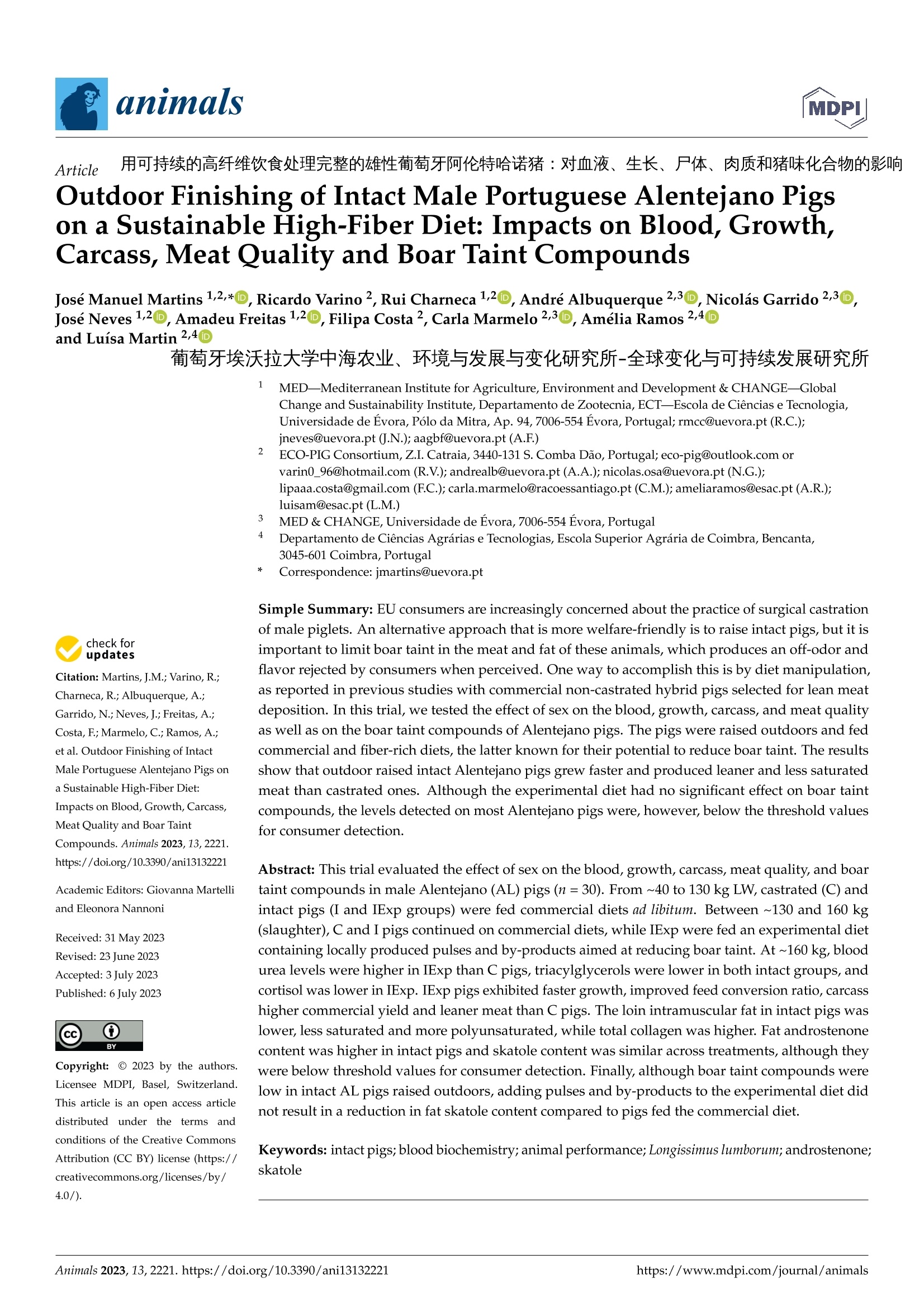
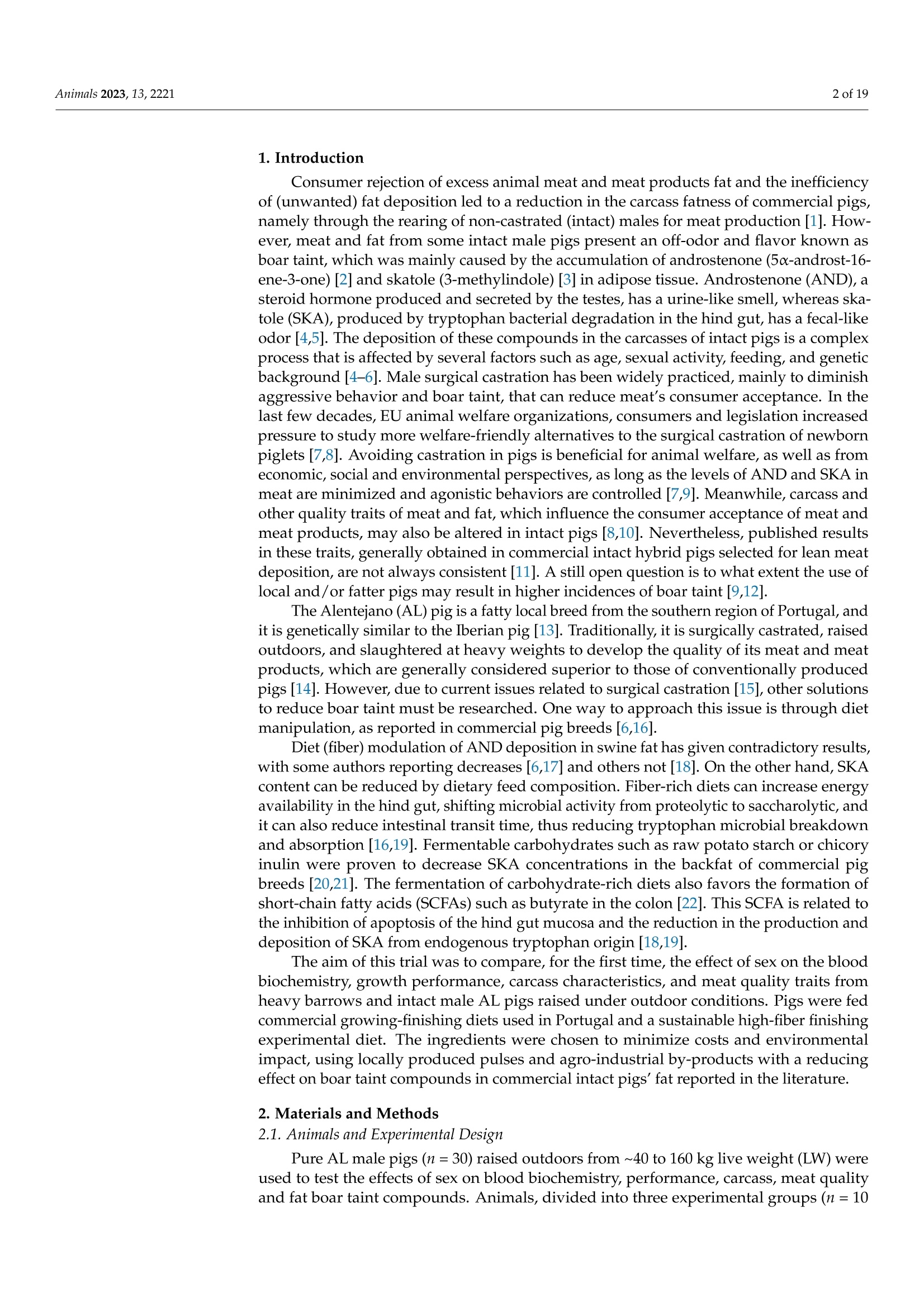
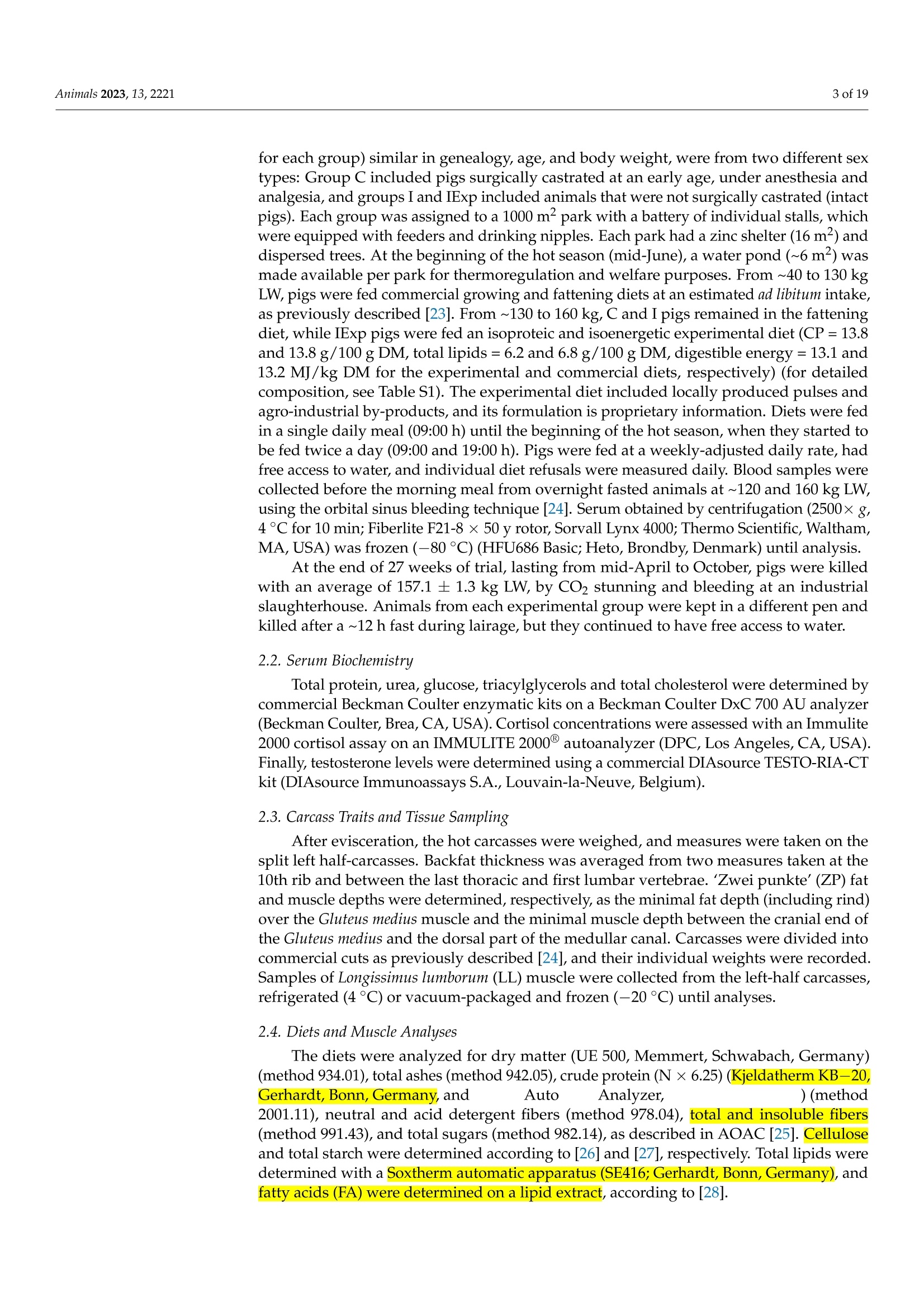
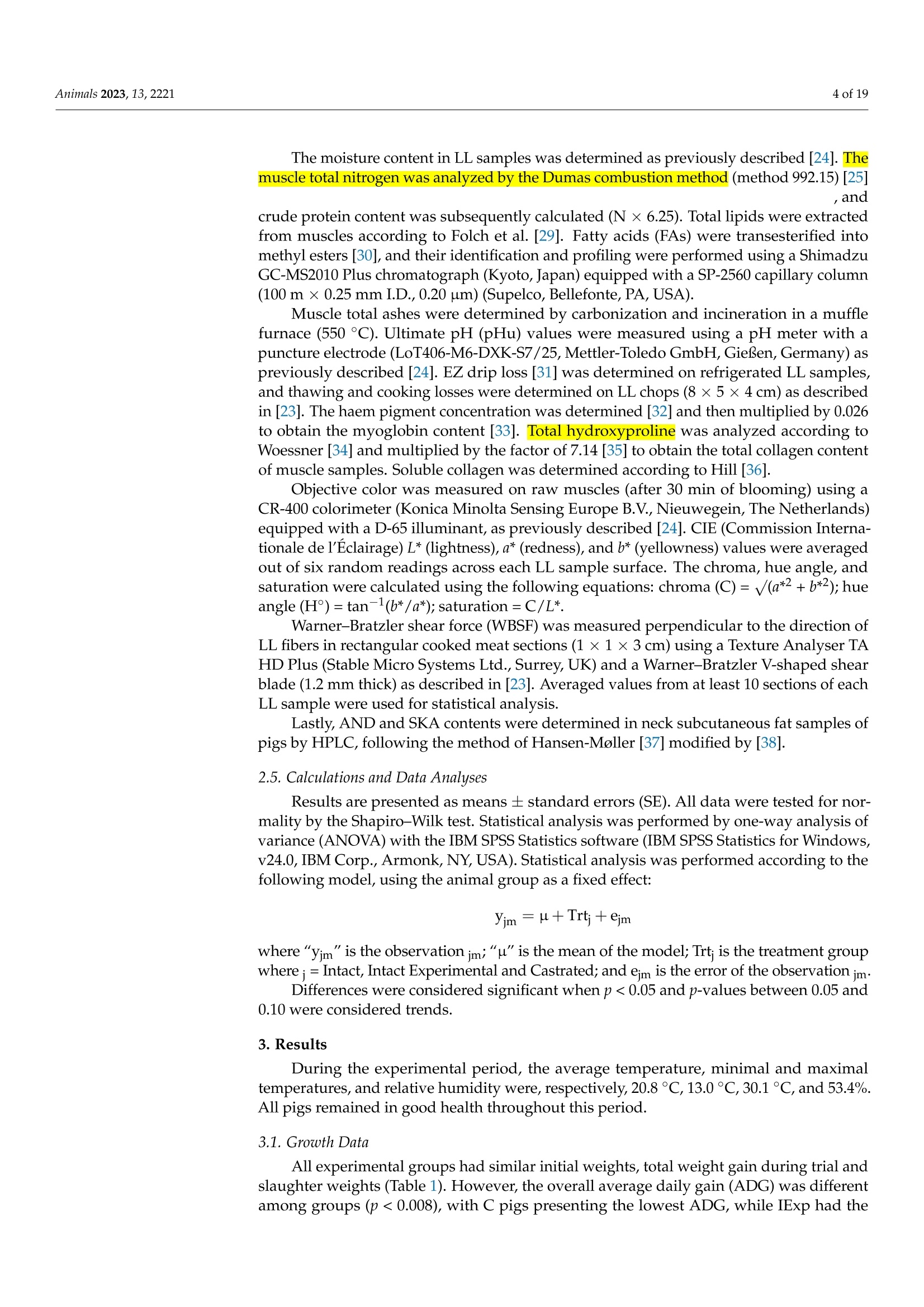
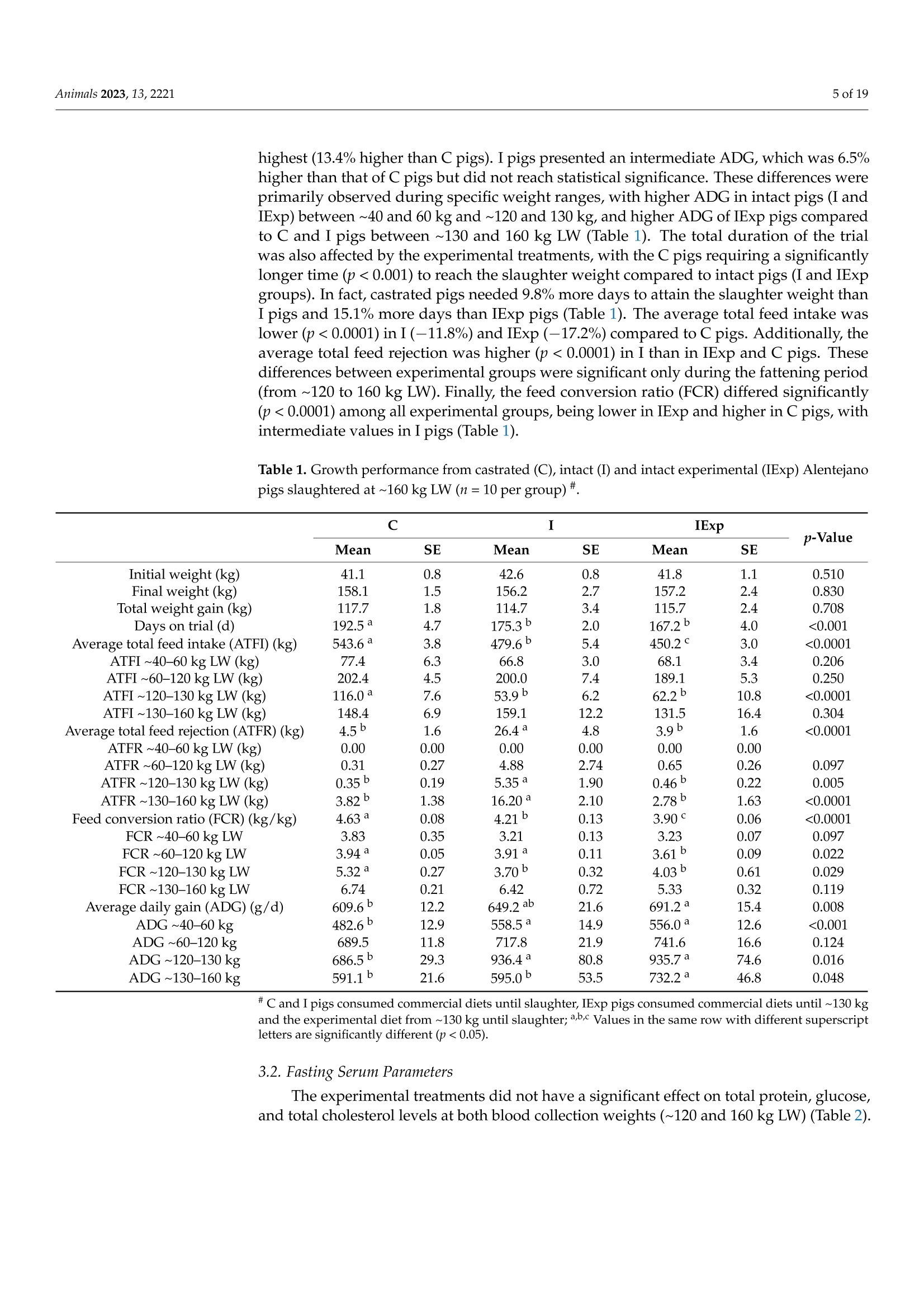
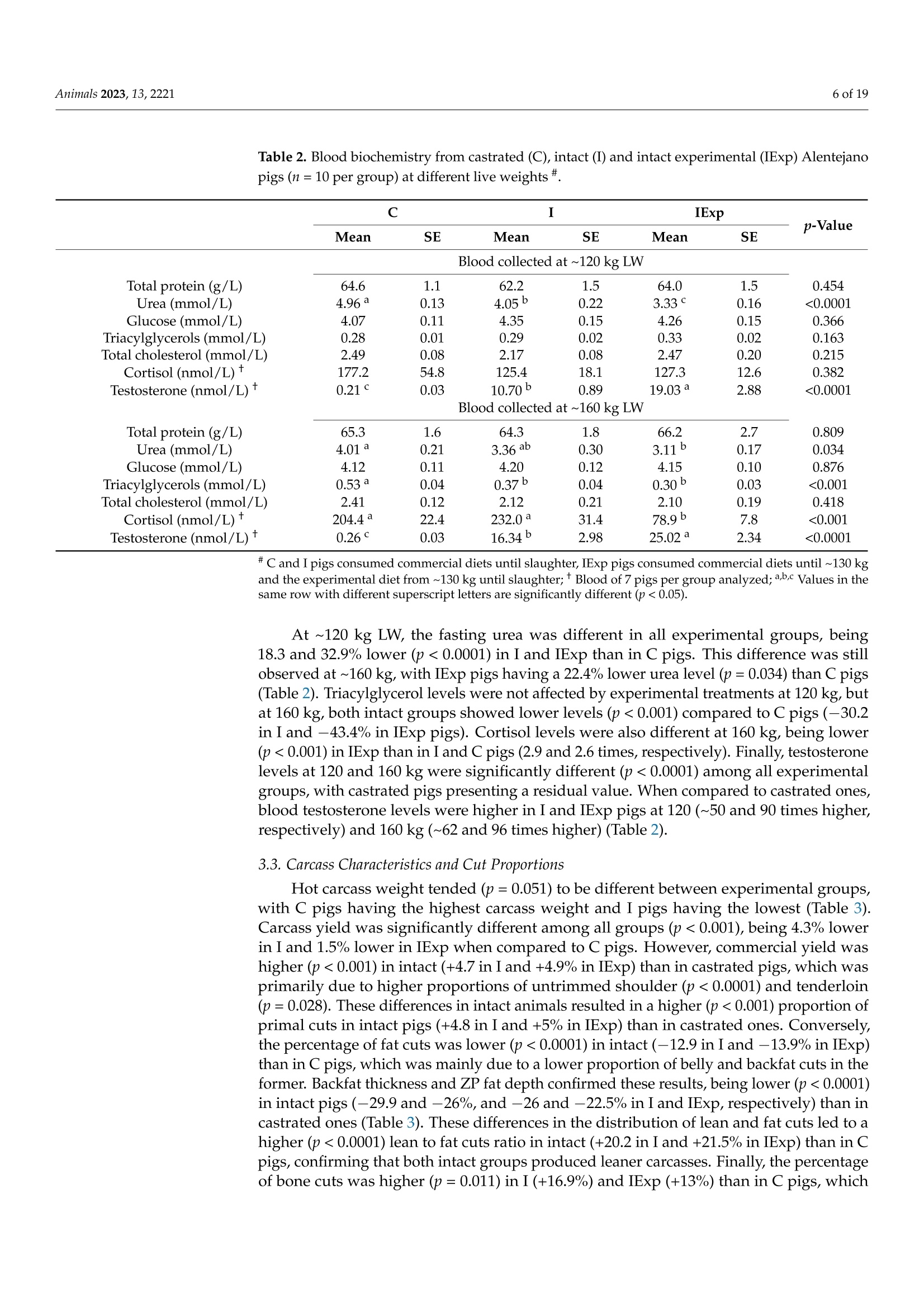
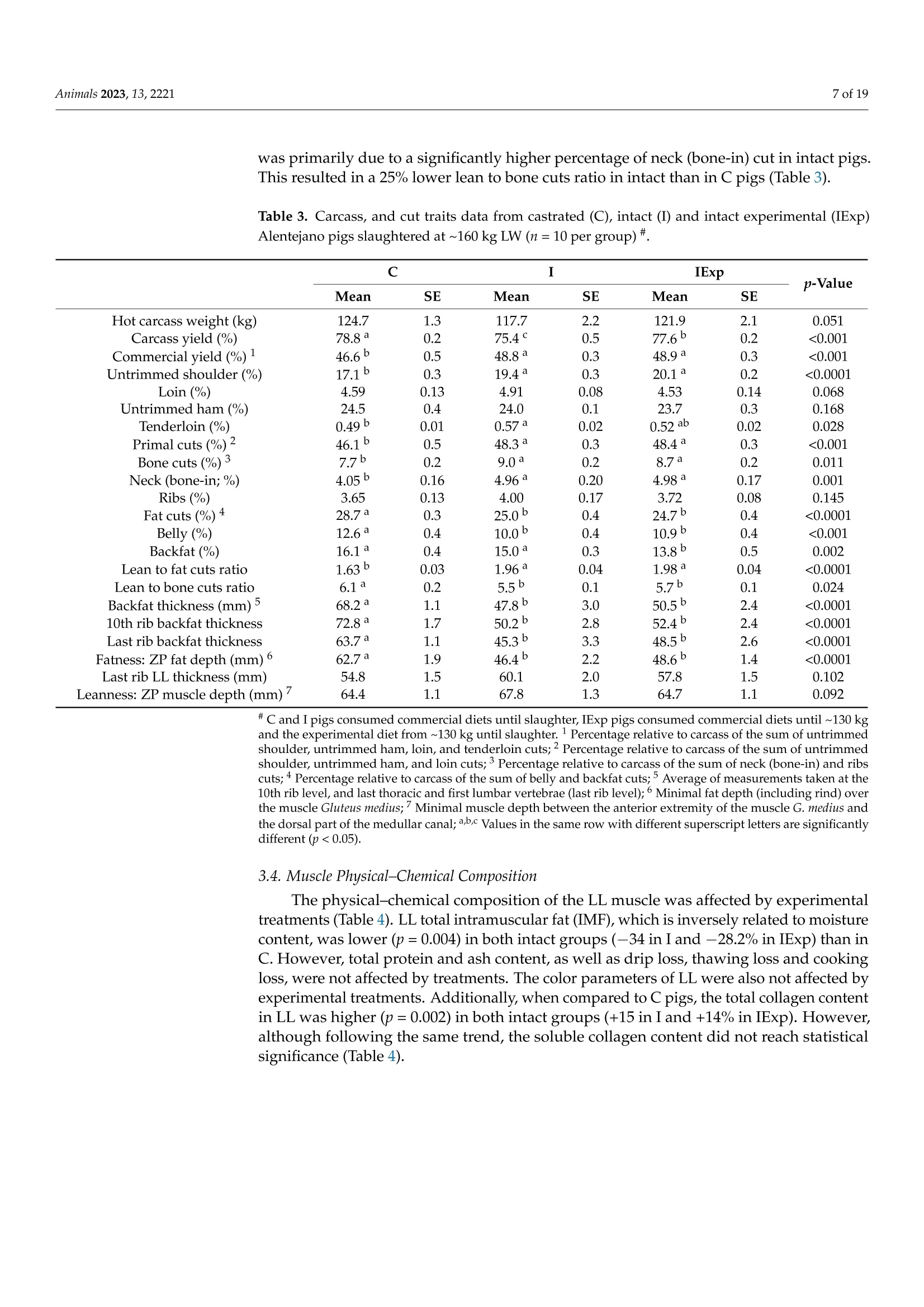
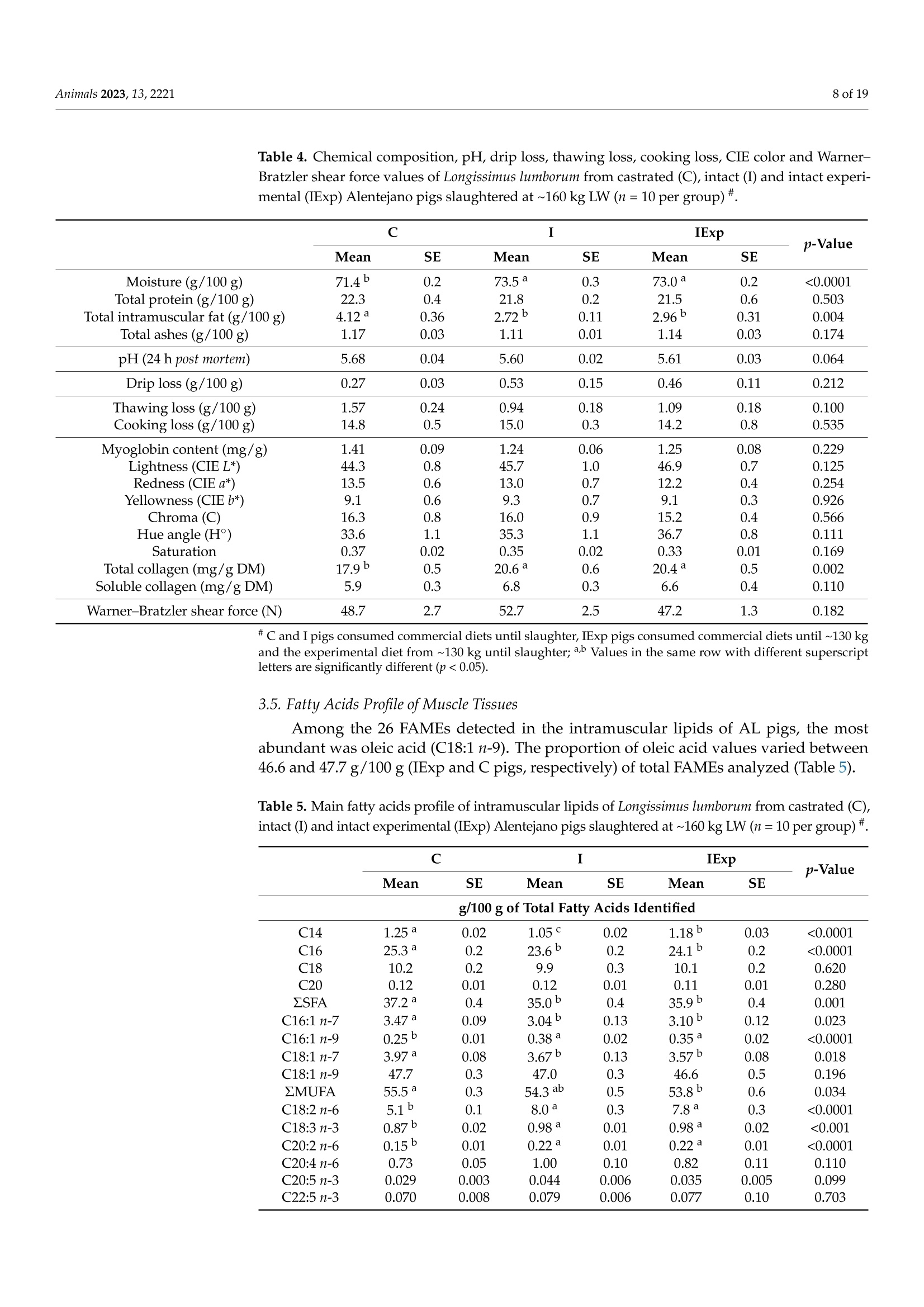
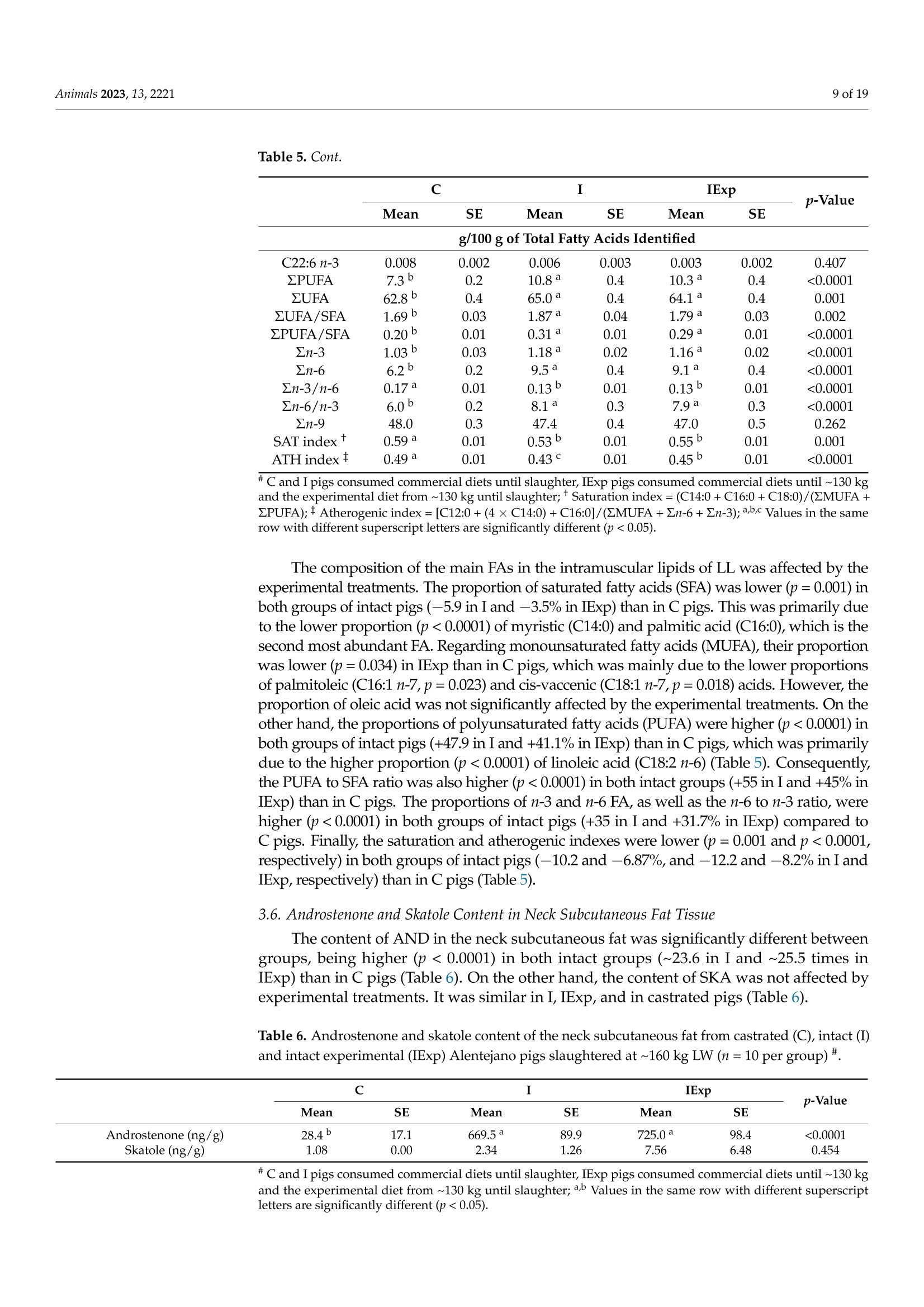
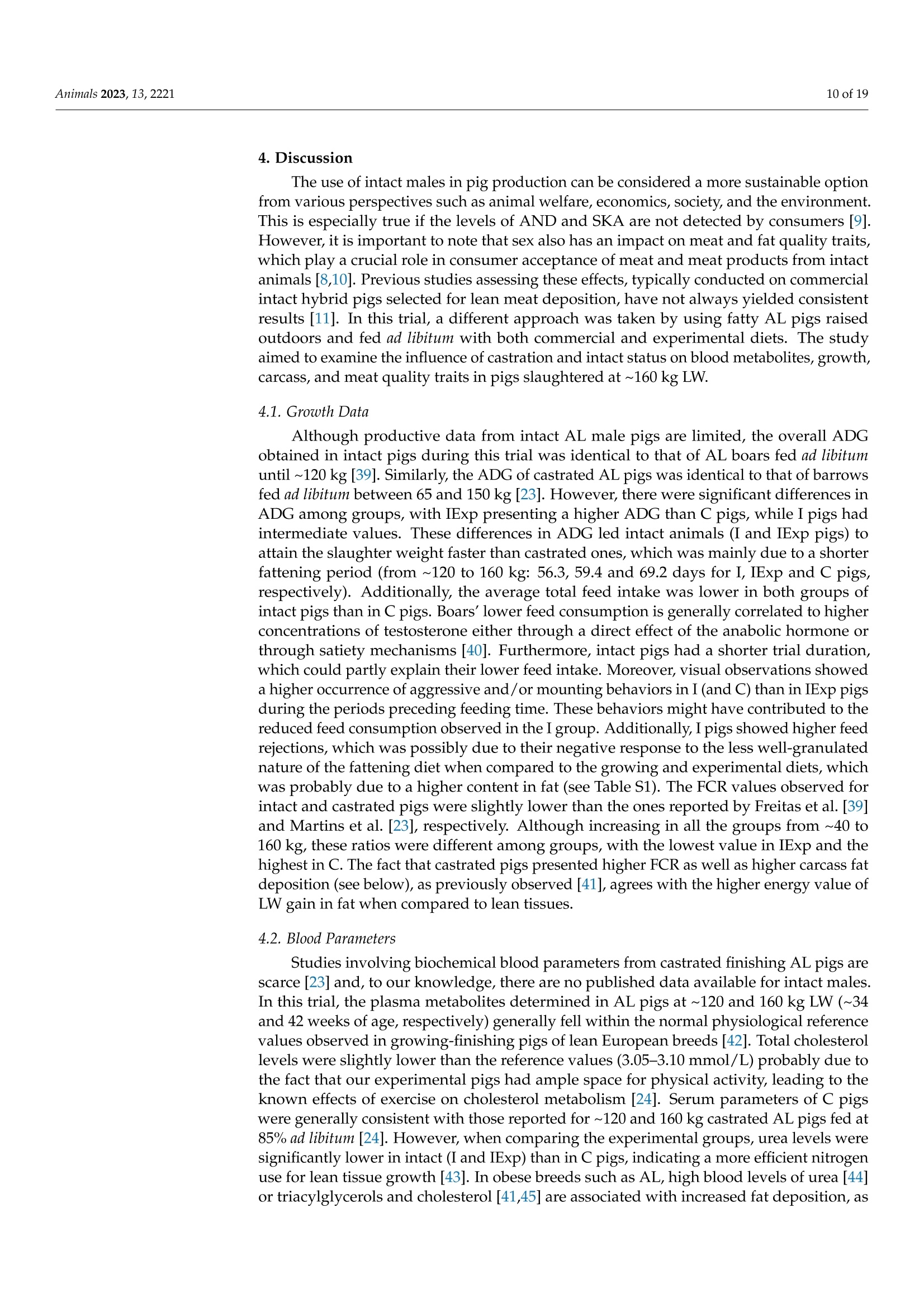
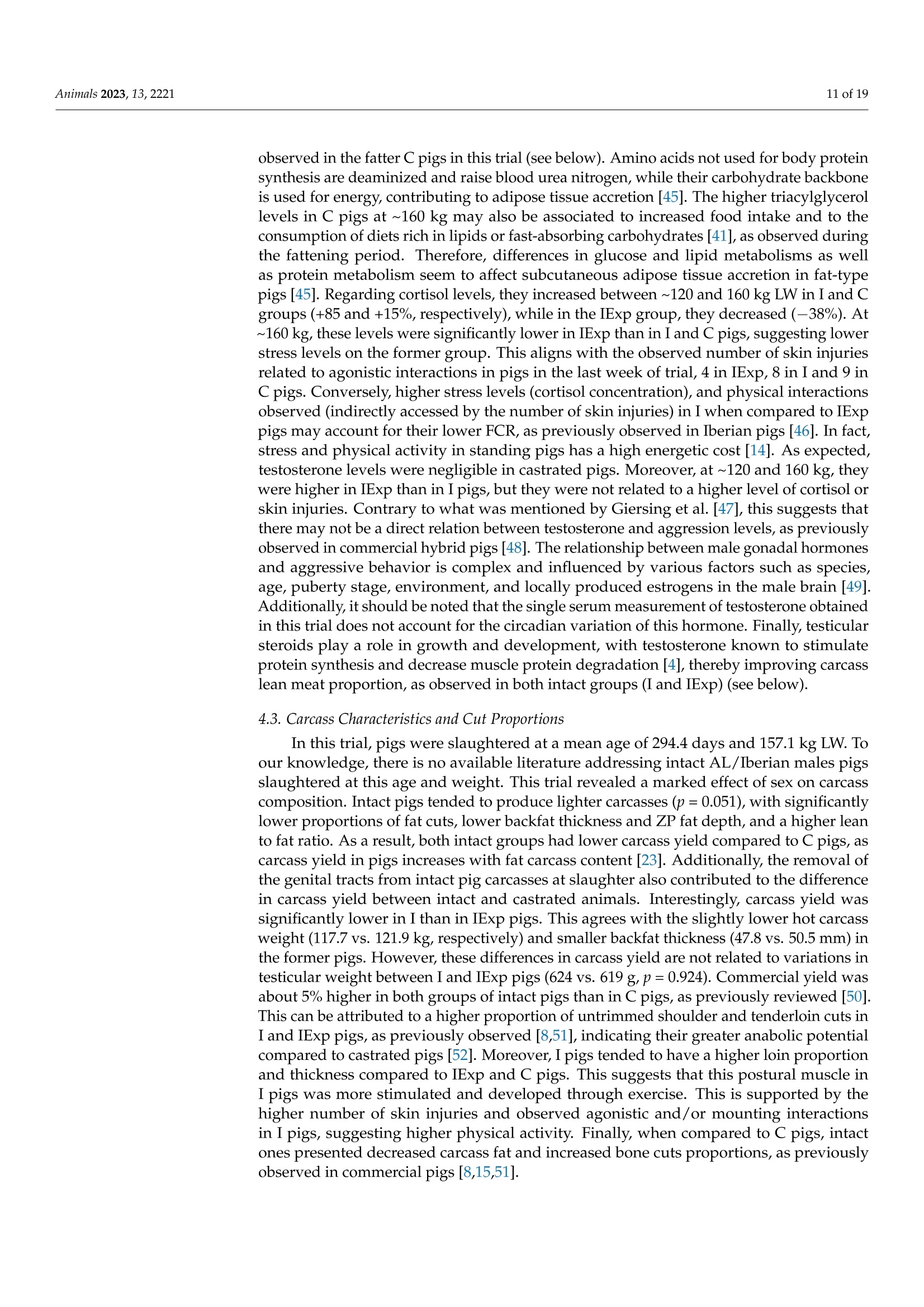
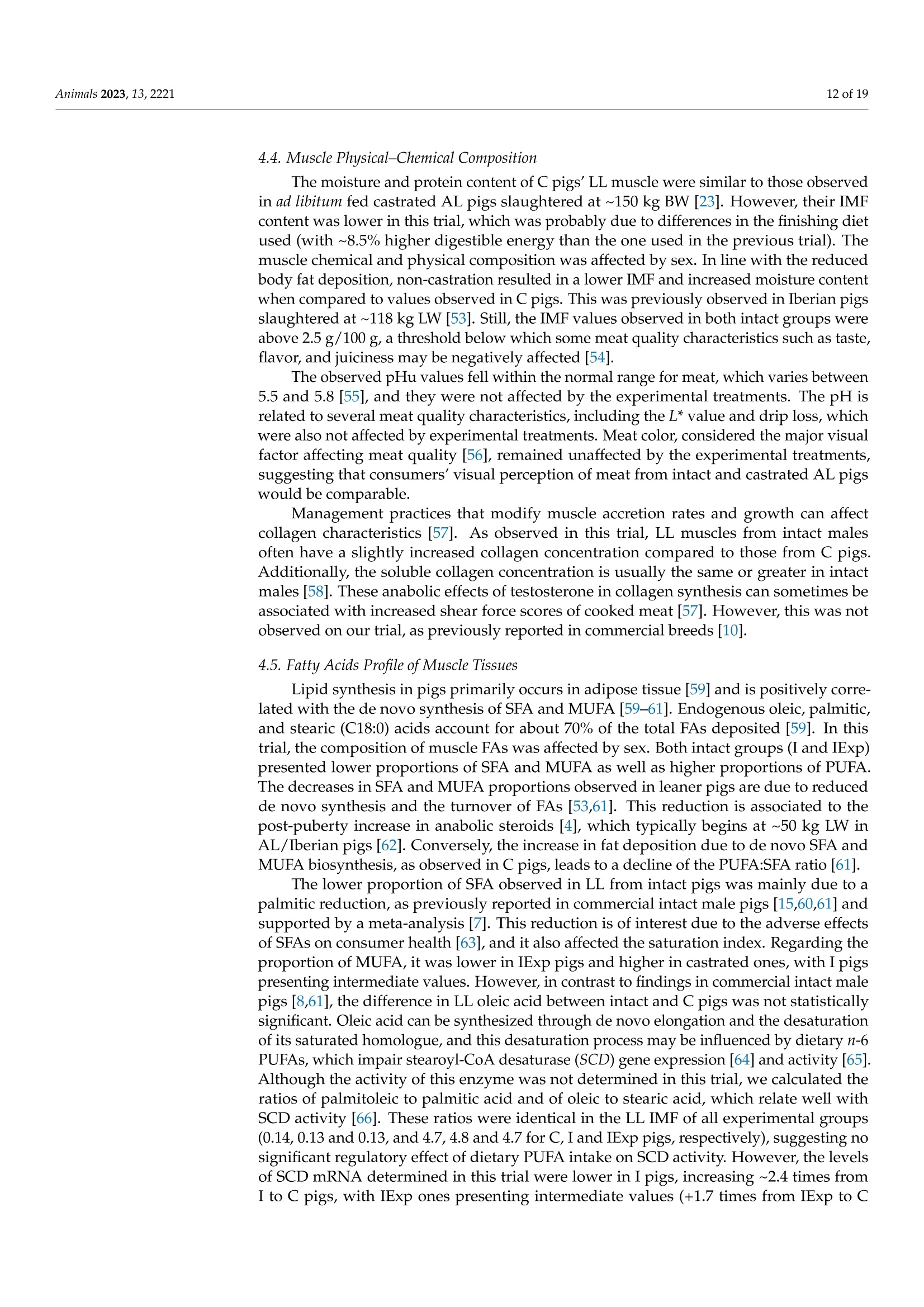
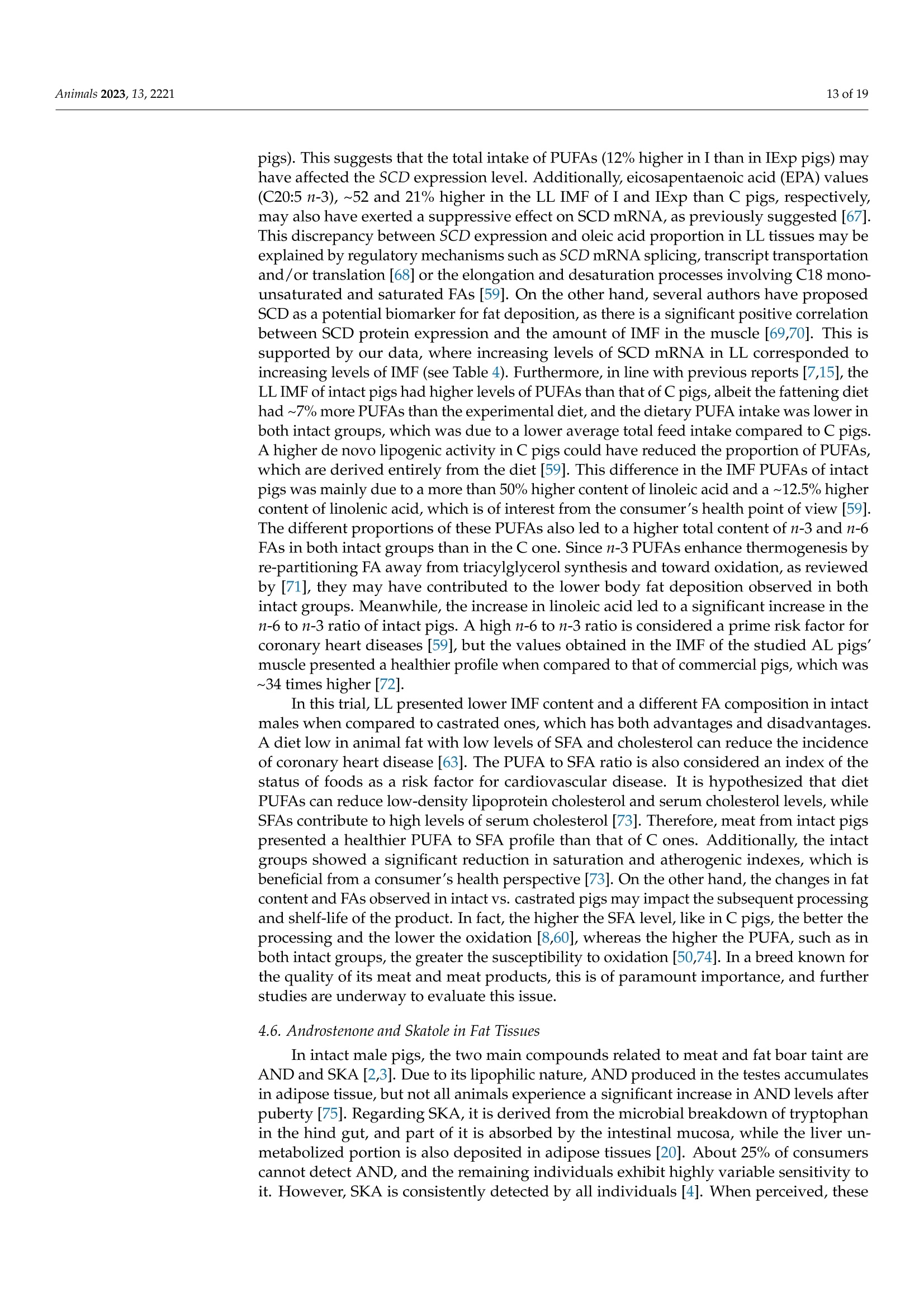
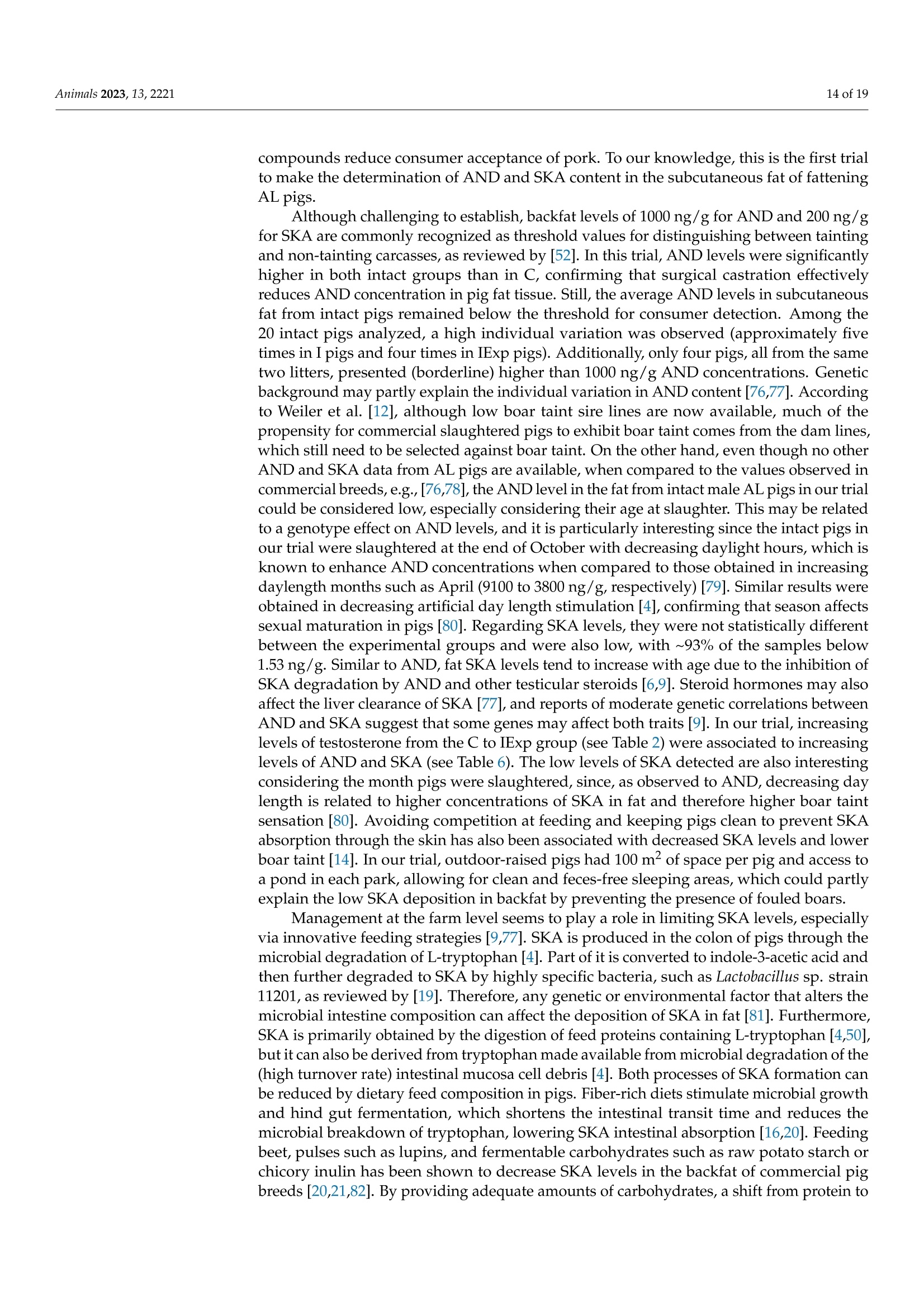
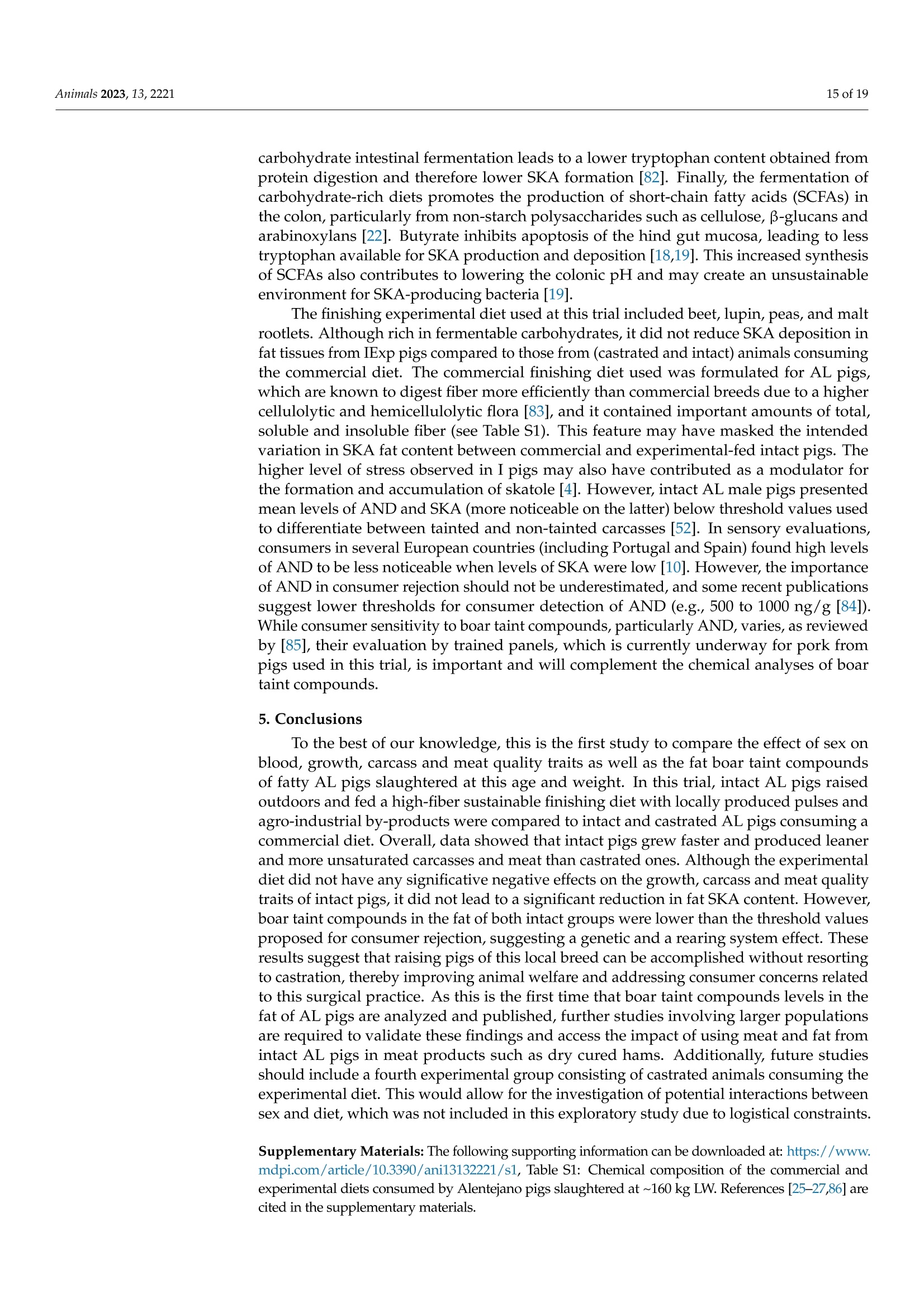
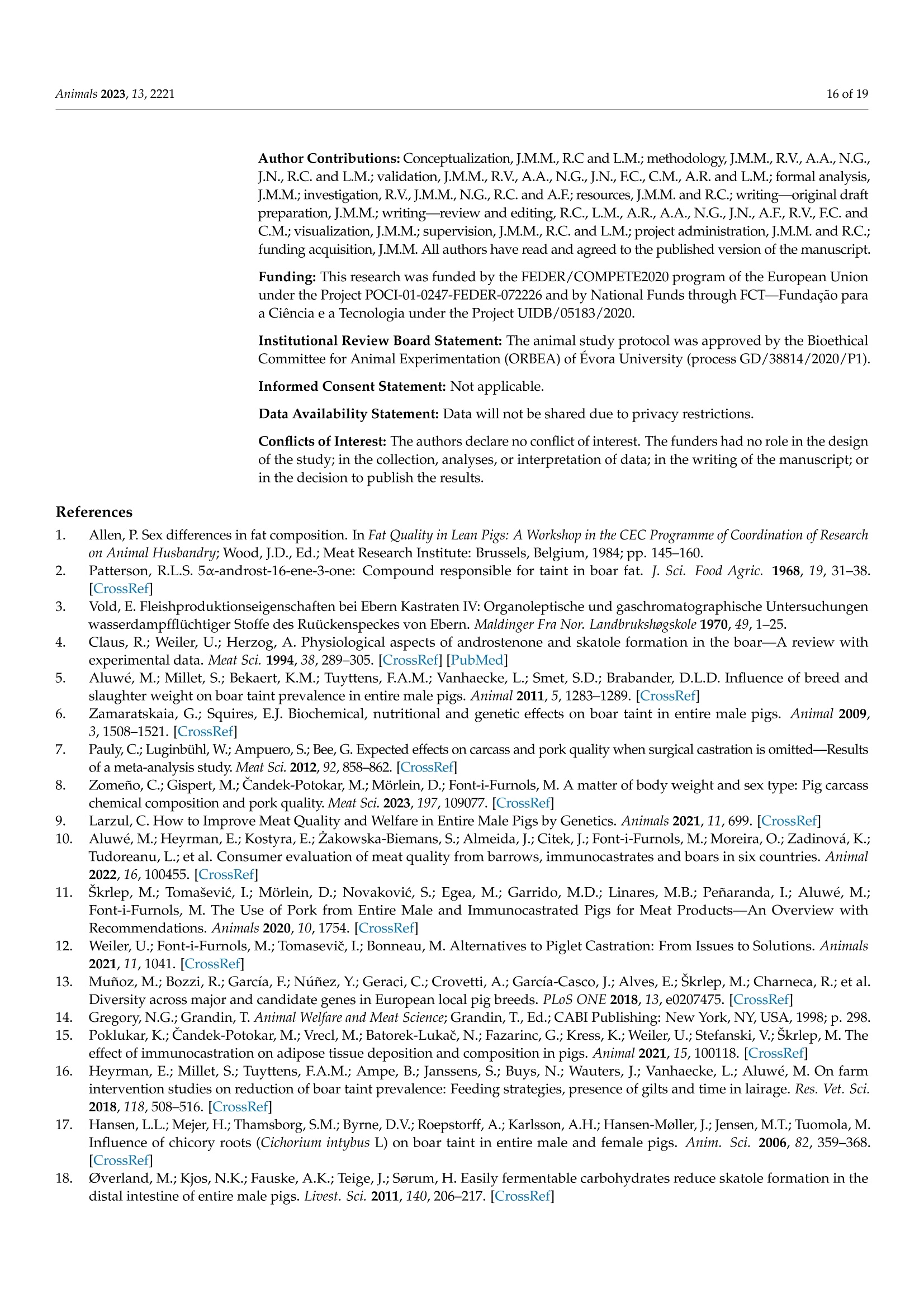
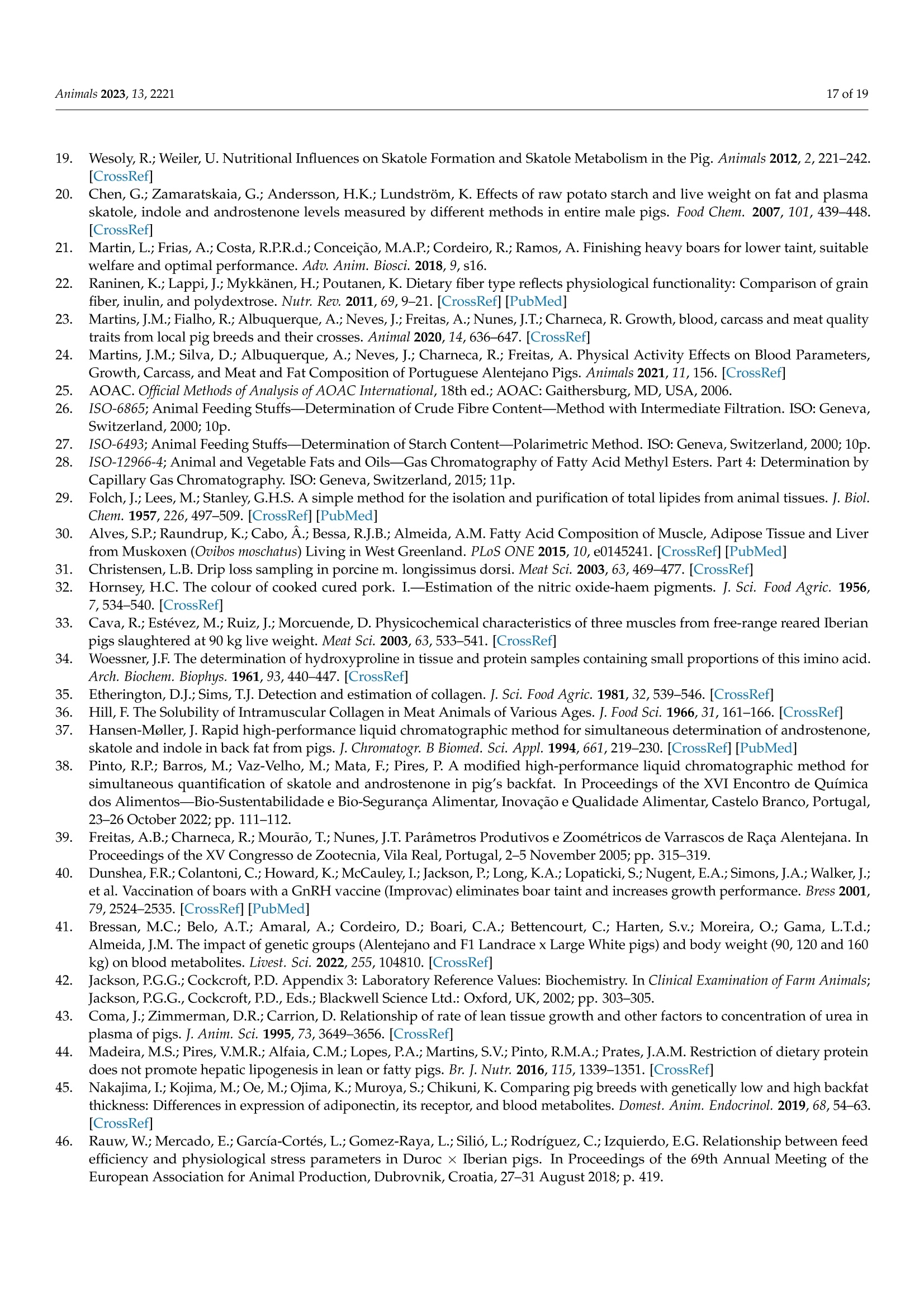
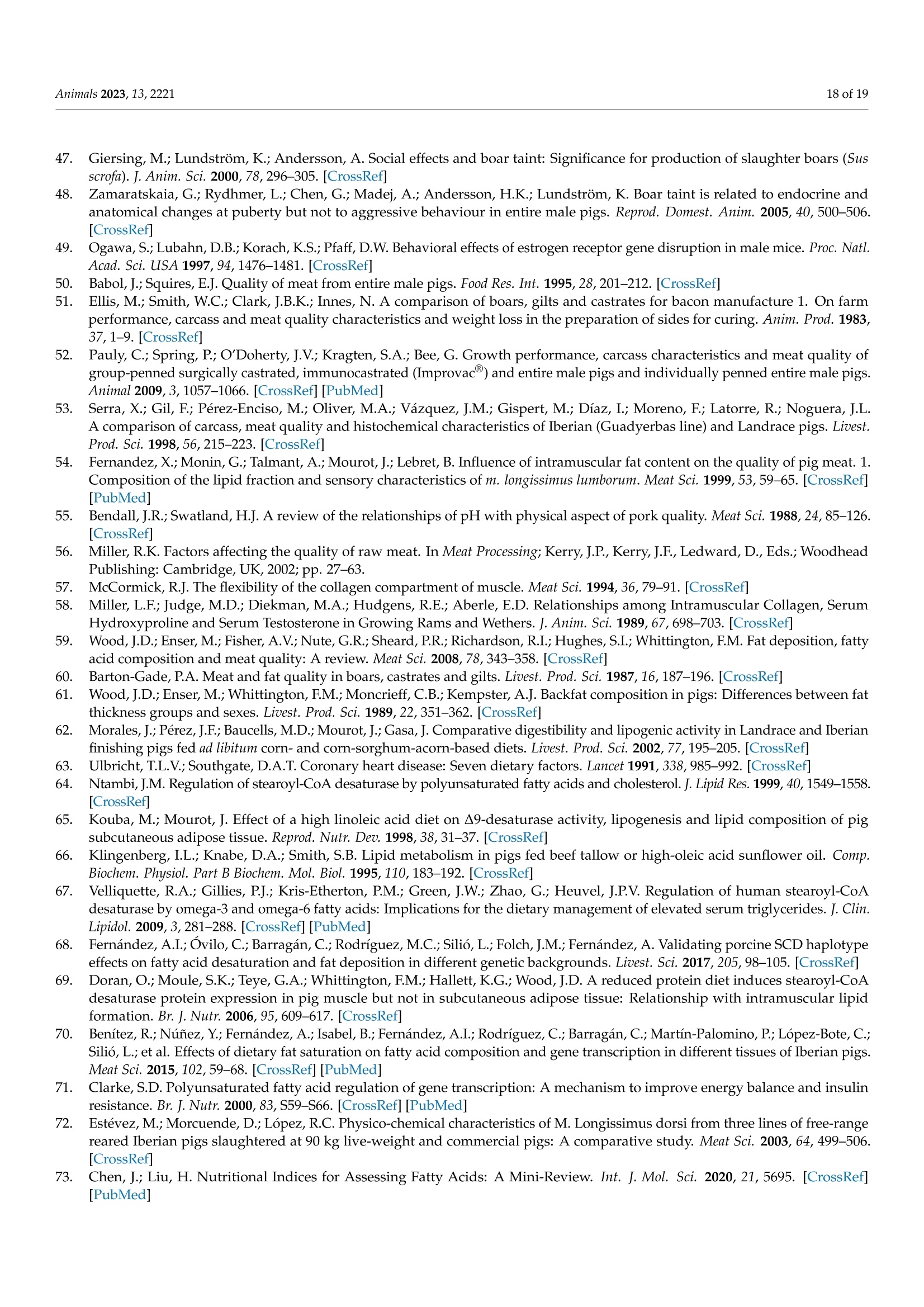

还剩17页未读,是否继续阅读?
中国格哈特为您提供《猪肉蛋白质和总脂肪含量以及猪饲料中蛋白质、总脂肪和膳食纤维含量检测》,该方案主要用于畜牧中动物营养与健康检测,参考标准《GB 5009.6 食品中脂肪的测定》,《猪肉蛋白质和总脂肪含量以及猪饲料中蛋白质、总脂肪和膳食纤维含量检测》用到的仪器有格哈特全自动超级总脂肪测定系统HT6+SOX416、格哈特自动升降凯氏定氮电热消解仪KT-L 20s、格哈特全自动型纤维分析仪FT12、格哈特带自动进样器凯氏定氮仪VAP500C、格哈特杜马斯定氮仪DT N Pro、德国移液器MM、凯氏定氮催化剂5.0g K2SO4+0.5g CuSO4 x 5H2O
相关方案
更多
该厂商其他方案
更多

